Report

Executive summary
In this, our first China Online Shopper Report, we draw on proprietary Alibaba data to paint the clearest picture ever of who China’s online shoppers are, how they shop and what it all means for companies hoping to sell to them. For this report, we have drawn key insights from the data produced by hundreds of millions of Tmall and Taobao consumers. It is the first time that this unparalleled data mine was made available for systematic analysis. We use it to explore the dimensions of a critical new direction in fast-moving consumer goods (FMCG): the major shift from a product focus—the traditional mindset of single-mindedly pursuing increases in gross merchandise value (GMV)—to a consumer-focused approach to selling, in which companies invest to accurately understand who the real consumers are and how they shop.
Written in collaboration with
Written in collaboration with

There is no question that the e-commerce channel, growing at an annual rate of 35%, is now the primary growth engine for China’s FMCG market. It has achieved high levels of penetration and become a core sales channel in subcategories as diverse as infant formula and color cosmetics.
The new digital capabilities and vast stores of data that e-commerce generates have helped transform forward-thinking consumer goods companies. Brands now have access to sophisticated consumer data that they could not have imagined even a few years ago. We have encouraged companies to use that rich data to inform their moves on three major battlefields: consumer strategy, product choices and marketing/promotion. The traditional product-centered approach has proven itself outmoded. The best companies now use what we call a consumer prism to more effectively build core brands, acquire consumers and fend off mounting competition from the likes of insurgent brands, while also winning persistent price wars. Only by focusing on consumers and their needs, and using that as their starting point, can brands outperform. With the growing importance of e-commerce as a sales channel, and the availability of invaluable data, it becomes increasingly clear that employing any other approach is akin to shooting in the dark.
Relying on Alibaba’s mountain of data and our insights gained from working with consumer goods and retail companies in China, we have identified eight strategic segments of China’s online consumers, the demographics and consumption behavior that define each distinct group, the role they play in a host of timely category trends and the touchpoints that appeal best to them.
Those consumer groups are Rookie White Collars, Wealthy Middle Class, Supermoms, Small-Town Youth, Gen Z, Urban Gray Hairs, Small-Town Mature Crowd and Urban Blue Collars. Collectively they account for 80% of FMCG platform users and represent over 90% of gross merchandise volume.
Upon further analysis, we determined that these eight groups fall into three clusters: Backbone consumers (Rookie White Collars, Wealthy Middle Class and Supermoms); New Power consumers (Small-Town Youth and Gen Z); and Blue Ocean consumers (Urban Gray Hairs, Small-Town Mature Crowd and Urban Blue Collars).
Rookie White Collars are educated people in their early 30s who live in Tier 1–3 cities. Their careers are advancing. They work in a fast-paced environment and greatly value convenience—hence, they prefer online shopping. They represent higher per-capita spending on Tmall and Taobao, with annual spending growth of around 20% from 2016 to 2018.
Wealthy Middle Class consists of financially stable consumers, typically in their early 40s. They live in Tier 1–3 cities, and primarily work as civil servants or in corporate middle or senior management. They are less passionate than their younger counterparts when buying the latest new products. As more rational consumers, they value quality, and a higher proportion of their online purchases are premium products.
Supermoms are women who are pregnant or have children under the age of 12. They live in Tier 1–3 cities and are concerned about raising healthy families while taking great care of their own careers—and their own health and beauty. They are the main shoppers for their families and are willing to pay a premium for convenience. Among all groups, they have the strongest spending power. It is reflected in the number of categories and brands they buy, their shopping frequency and the amount they spend.
These three segments can best be described with three simple words: saturated, sophisticated, premium. Their online penetration has reached a plateau, exceeding 70% for each of the three groups in 2018. These three segments represent the core of online sales, contributing more than 60% of the gross merchandise volume for FMCG platforms. They maintain sophisticated standards, buying the highest number of brands, and spending the most on premium products and foreign brands. The brands that communicate best with these consumers use key words in marketing relating to specific products, places of origin and ingredients. Insurgent brands that meet their demands for quality are gaining strong growth momentum in both sales volume and average selling prices.
Gen Z consists of students or others born after 1995 and living in Tier 1–3 cities. These consumers are digital natives. Unlike their older counterparts, they value trendy items over established brands and are major fans of insurgent brands. This group represented the fastest per-capita spending growth on Tmall and Taobao FMCG, with per-capita spending growing 30% annually from 2016 to 2018.
Small-Town Youth are consumers in their 20s in Tier 4 or smaller cities. They take their cues from big-city youth, eagerly following the latest urban trends. Without the pressure of exorbitant housing prices, they have considerable disposable income at their fingertips. The slow pace of life also provides them with enough time to enjoy games, video streaming and other online leisure activities. Their income and free time make them a huge potential force in online shopping.
Gen Z and Small-Town Youth are the most dynamic segments. They represent the highest growth in the consumer base and number of transactions. In addition, their value-per-transaction growth remains robust. As they gain in spending power, they eagerly trade up to premium products. They thirst for new products and are the consumers who purchase new brands at the fastest rate. They strongly prefer content-rich marketing touchpoints and are devoted followers of key opinion leaders. These youngsters are active in brand blogs such as Weitao and new-product-focused channels such as Free Trial and Tmall’s Hey Box.
Urban Gray Hairs are consumers born before 1970 who live in Tier 1–3 cities. The majority of them are retired and have substantial pensions. This group could be considered a hidden gold mine for online sellers. They now spend relatively little online. In fact, their per-capita spending dropped 20% annually from 2016 to 2018.
Small-Town Mature Crowd consumers are older than 35 and live in Tier 4 or smaller cities. With their slow pace of life, they typically have an abundance of time to watch videos or news online. They make most of their purchases offline, a preference that allows them to socialize with acquaintances face-to-face. The Small-Town Mature Crowd registered the lowest per-capita FMCG spending on Tmall and Taobao of any group in 2018.
Urban Blue Collars are less affluent consumers in Tier 1–3 cities who are typically engaged in such professions as catering, transportation or retail. They are familiar with the same e-commerce infrastructure and online channels that influence their middle-class counterparts. Yet, compared with the Rookie White Collars or Wealthy Middle Class groups, they are more concerned about value for their money when shopping online and tend to buy fewer items. Their per-capita spending on Tmall and Taobao is far below that of middle-class shoppers and grew at a relatively slow 5% rate from 2016 to 2018.
The population of these last three segments may be large, but their online penetration remains low. In fact, both the Small-Town Mature Crowd and Urban Gray Hairs have less than 20% penetration on Tmall and Taobao FMCG platforms.¹ However, the large population and low penetration suggests that they hold great potential for conversion to online shopping with the right cultivation. These consumers want “value for the money”—they aspire to buy high-quality products at the lowest possible prices. In most categories studied, the value per transaction is dropping for the products they purchase, as they outspend their counterparts in other clusters through discount-oriented channels such as Daily Deals and Special Selected. Furthermore, they favor simple approaches to communication. For example, they are most likely to react to online displays that feature few products and simple, direct descriptions. In addition, they tend to favor user-acquisition events, such as WeChat group buying events initiated by friends or acquaintances.
How brands can win
Winning online means adopting a consumer-centered mindset and regarding strategic consumer groups as the cornerstone for competitive strategy. Brands can follow a four-step process for turning that strategy into action.
Step 1. Clearly understand the targeted strategic consumer groups and their preferences in products and content/promotion channels
There is no “one-size-fits-all” standard of strategic consumer group segmentation that applies for all brands. In fact, segmentation widely varies for different product categories and subcategories. Brands should make use of the massive data sets available to systematically and accurately classify their unique strategic consumer groups. For example, strategic consumers in the infant formula category can be segmented according to roles, such as different types of parents and grandparents, as well as various occasions, such as self-indulgence or gifts to friends. Furthermore, a brand needs to analyze both its own strategic positioning and the industry landscape before determining its targeted strategic consumer groups.
Step 2. Identify key growth drivers to customize a category- and brand-specific strategy
After identifying the strategic consumer groups, brands need to look at three measures: penetration (number of consumers who buy the brand), repurchasing (consumption frequency) and premiumization (average value per transaction). This enables them to identify the growth drivers for key strategic consumer groups and empowers companies to create a customized category and brand strategy (see Figure 1).
By evaluating penetration, repurchasing and average value of transactions, brands can focus on the growth drivers for each consumer group

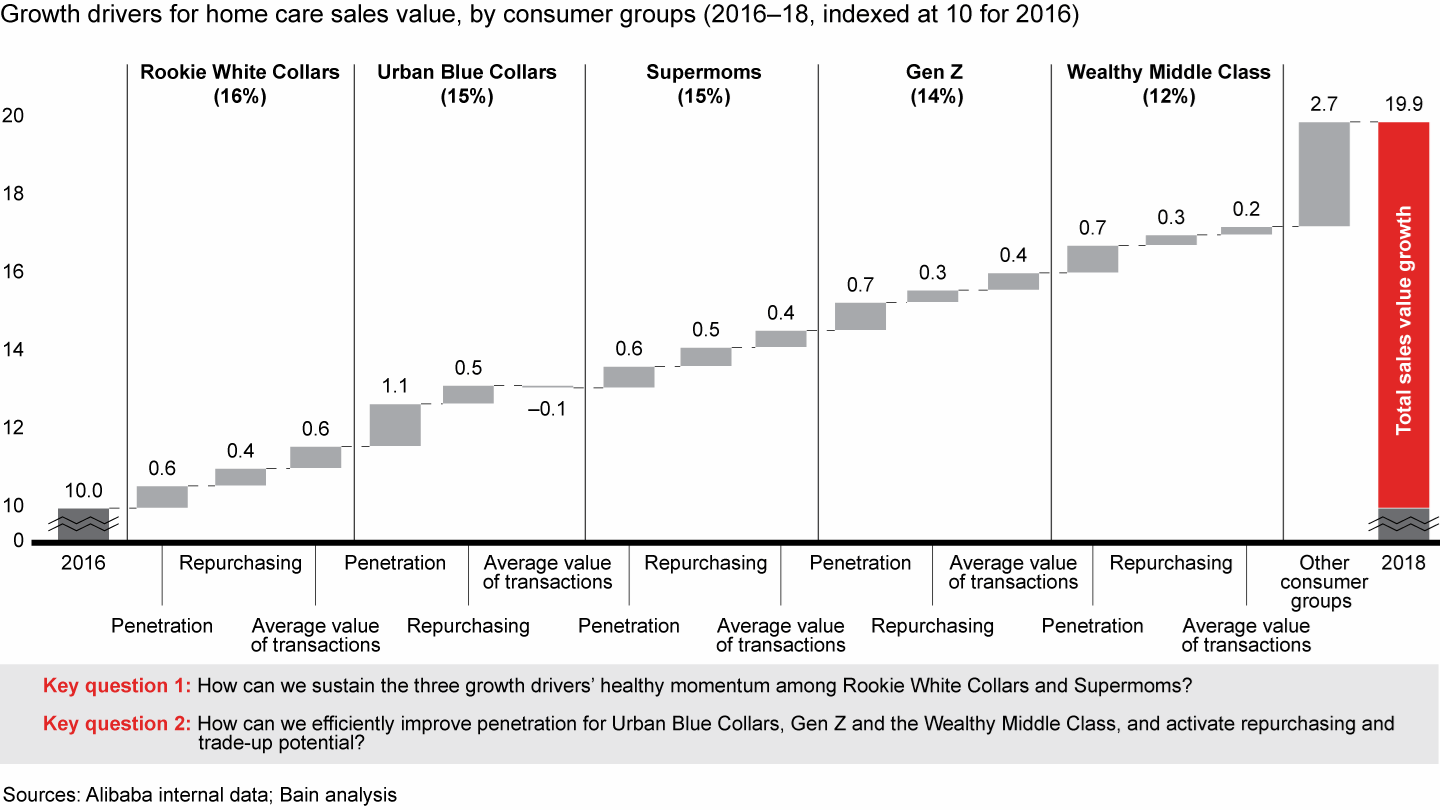
In home care, we identified the top five contributors to sales growth from 2016 to 2018: Rookie White Collars, Urban Blue Collars, Supermoms, Gen Z and the Wealthy Middle Class. Combined, these five consumer groups represented more than 70% of the sales growth in home care categories.
When we closely examine the data, we see that penetration, repurchasing and premiumization among Rookie White Collars and Supermoms maintained healthy growth, indicating that brands can further acquire new consumers, foster consumer loyalty and drive premiumization in these two groups.
Meanwhile, penetration improvement plays a big role in increasing sales growth among Gen Z, the Wealthy Middle Class and especially Urban Blue Collars. Brands can adapt their product portfolios (introduce high-value-for-the-money products for Urban Blue Collars or innovative products that highlight emotional propositions for Gen Z) and use specific marketing tools that have higher conversion rates among Urban Blue Collars and Gen Z to attract new consumers efficiently. However, among these three consumer groups, repurchasing and premiumization has a limited influence on sales—in fact, average value per transaction declined for Urban Blue Collars. Brands should consider ways to activate repurchasing and trading up.
Step 3. Optimize product portfolios, marketing and channel strategy—choosing key growth initiatives for reaching and converting targeted consumers
Based on their precise analysis of growth drivers for strategic consumer groups, brands can optimize their marketing and channel strategies and product portfolios to reach and convert consumers more efficiently. Companies can pursue the eight strategic segments by taking these steps.
- Improve product-consumer matching. Continuously optimize the product portfolio to match consumer needs for product functions, price and specifications. For example, as Backbone consumers focus on the ingredients of skin care products and premiumization, beauty brands should continuously encourage trading up by strengthening the premium products in their brand portfolio, developing high-value and personalized products, and embracing new technologies and leading intellectual property to activate incumbent brands.
- Optimize marketing investment. Comprehensively evaluate how marketing tools influence the end-to-end consumer journey in terms of brand and product granularity, and enhance capabilities and investment in related marketing tools to meet the demands of strategic consumer groups. For instance, young people look for key opinion leaders’ recommendations for new products and promotions. Brands can embrace those opinion leaders and invest heavily in popular content channels like the Weitao store blog, a favorite of young consumers, to maximize marketing ROI.
- Optimize channel portfolio. Give full play to the greatest advantages of different channels and make them complement each other. For online channels, brands can position flagship stores as their main platform for branding, new-product launches and consumer education interaction. They can position C2C stores to test insurgent and niche brands as platforms on which they can cooperate better with key opinion leaders.
We have determined the best ways that companies pursue the three strategic consumer clusters (see Figure 2).
Different consumer groups in China require different paths to success

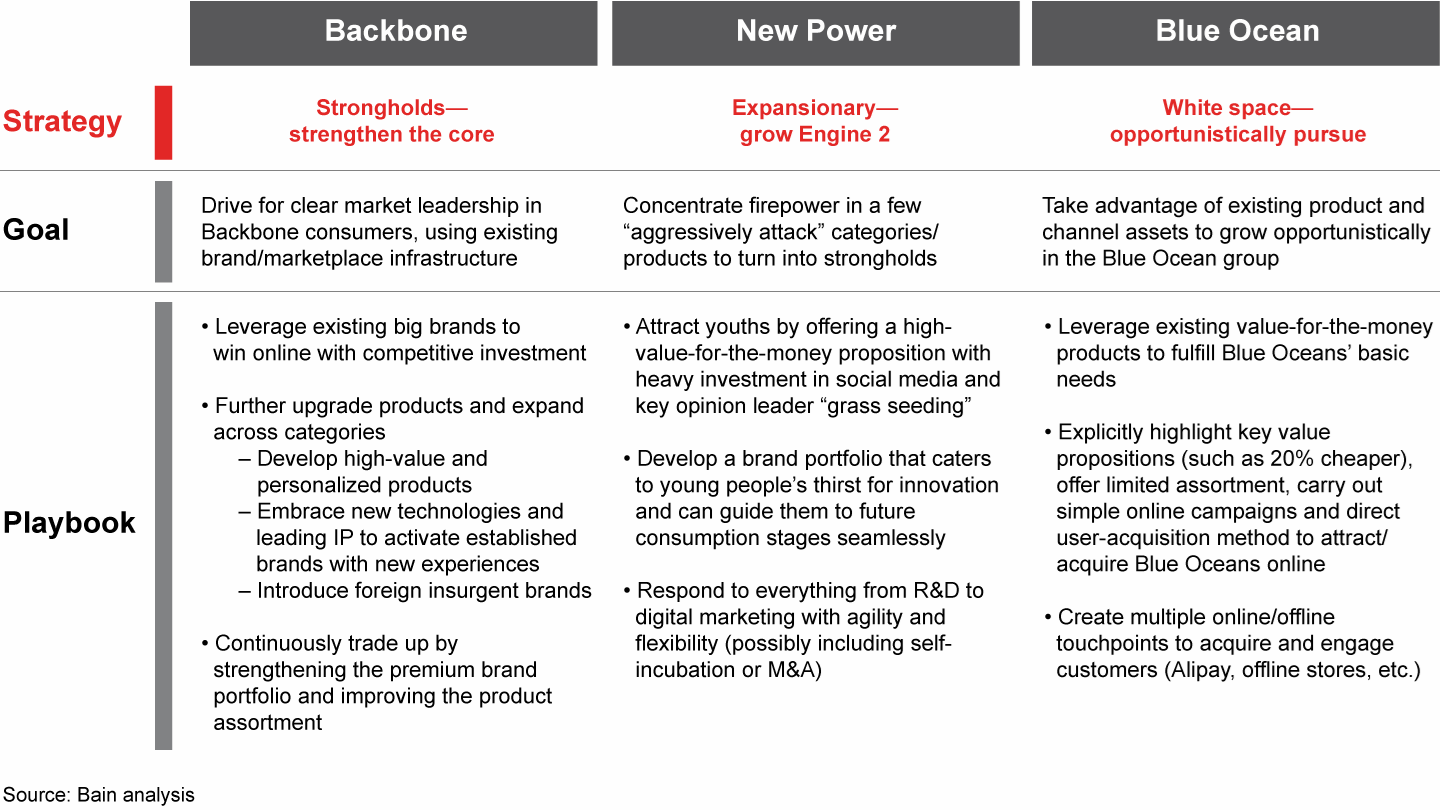
Step 4. Systematically review and continuously improve strategic initiatives
Consumer data makes the route from awareness to purchase more traceable than ever, allowing companies to track and evaluate the sales conversion process. Brands can establish a brand-asset dashboard to track real-time results and make adjustments along the full AIPL (awareness–interest–purchase–loyalty) journey. Brands can optimize their management of consumer assets—brand awareness, operational efficiency, brand loyalty and consumer quality.
Dashboards can be populated from the data generated by hundreds of millions of online consumers, with high granularity down to the brand and SKU level. Companies can view the data based on each action along the AIPL journey, as consumers click and browse, search for products, inquire about products, add products to their list of favorites, add them to shopping carts, complete purchases, recommend products, join loyalty programs and become active members. Each indicator can be benchmarked against historical data and industry averages.
Moreover, brands can develop a customized KPI (key performance indicator) dashboard based on their development status and strategic positioning. They can allocate different weights to different consumer metrics as well as gross merchandise value metrics, reviewing the effectiveness of strategic initiatives from an integrated view and with an eye toward continuous improvement.
To boost ongoing engagement with targeted consumer groups, brands should become data-driven, consumer-centric organizations that develop their own sets of consumer data while also collaborating with outside platforms.
In the evolving FMCG market, the boundaries of categories are blurring, and the consumer touchpoints are changing fast. Only by focusing on consumers can brands capture future growth opportunities. This four-step playbook provides the right path. Bain and Alibaba will continue to work with consumer goods companies to generate the consumer insights and actions that will lead brands to achieve their full growth potential—and we will continue sharing our findings in future reports.
Full report
Preface
E-commerce is the engine that is propelling the growth of China’s fast-moving consumer goods market and leading it into exciting new directions. Consider that online sales rose by 35% annually from 2014 to 2018. This compares with 5% growth for the total FMCG markets (see Figure 3). In 2018, e-commerce contributed 17% of all FMCG sales, emerging as huge competition for such traditional channels as hypermarkets and supermarkets. Already achieving high penetration for categories like color cosmetics and infant formula, it is quickly becoming a channel of choice for purchases in personal wash, oral care and others where its penetration is steadily growing (see Figure 4). As e-commerce gains prominence and wins the hearts of more shoppers, it reveals two undeniable facts of life. First, companies will need to invest in a digital transformation to build the new digital capabilities required to make the most of e-commerce. Second, winning in China means winning the battle online. That starts with making a different type of transformation—moving from a strategic brand approach built around products to one built around consumers (see Figure 5).
E-commerce has become a major channel for sales of fast-moving consumer goods in China

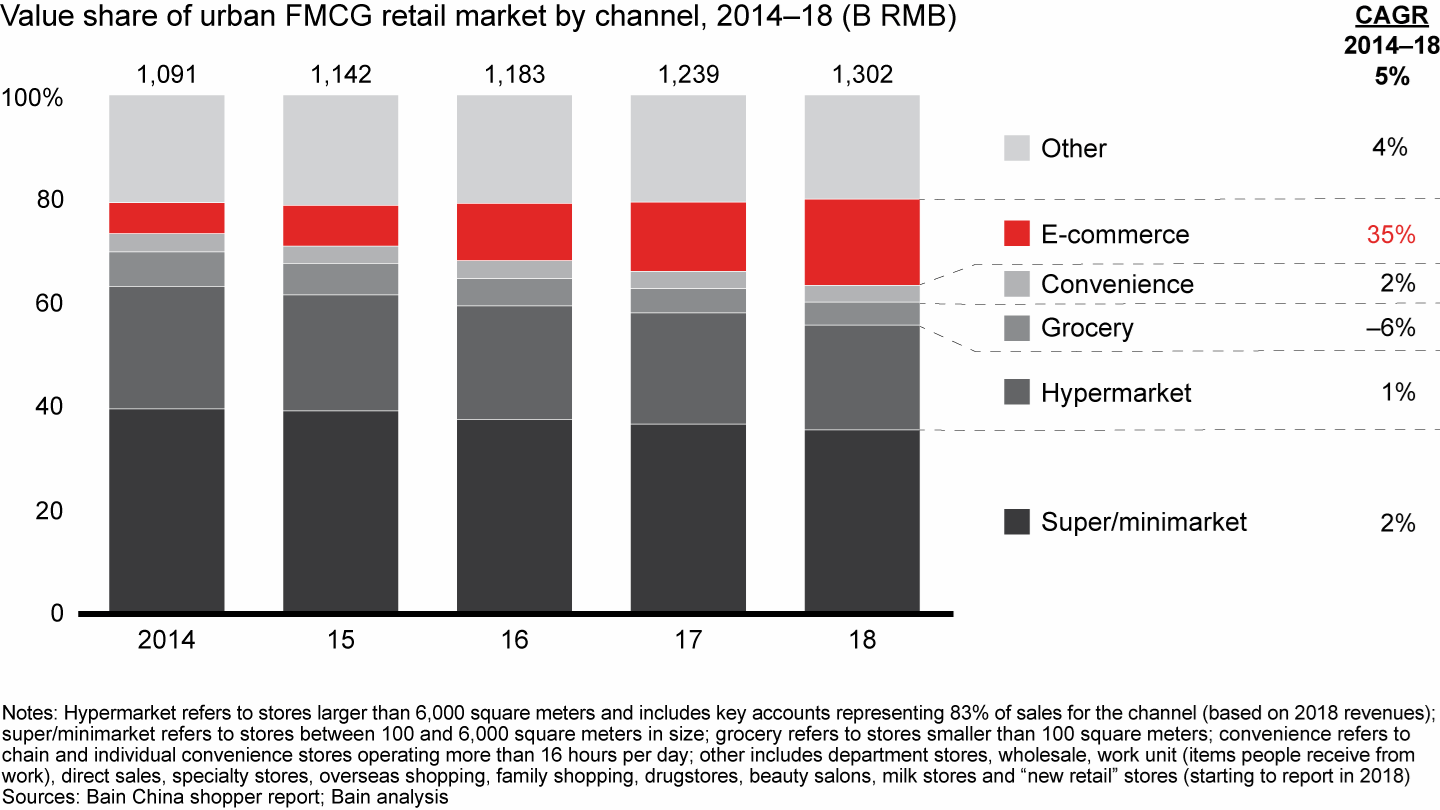
Categories such as beauty and infant formula have achieved high online penetration

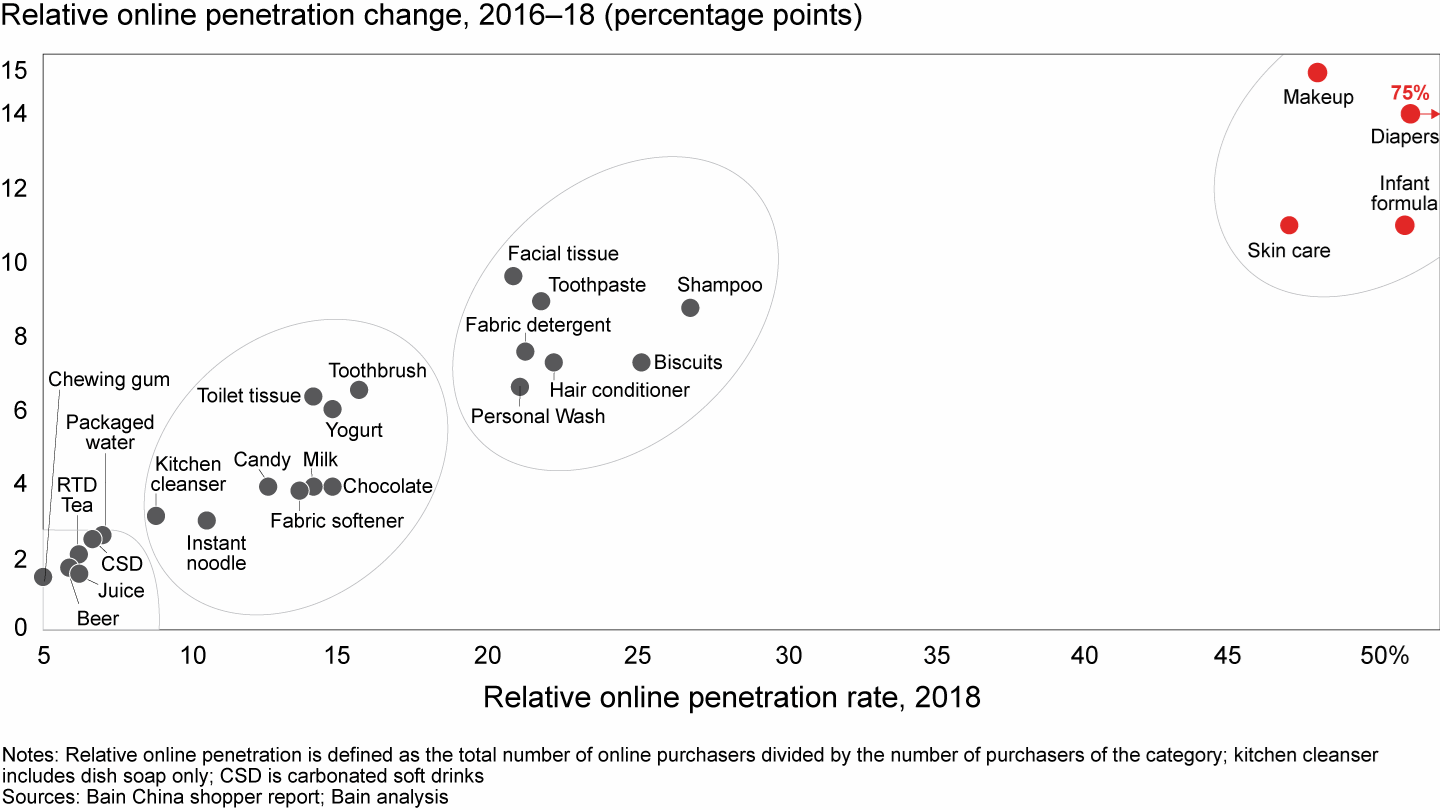
Strategic consumer segments are based on demographics and shopping behavior, combined with Tmall’s existing consumer labels

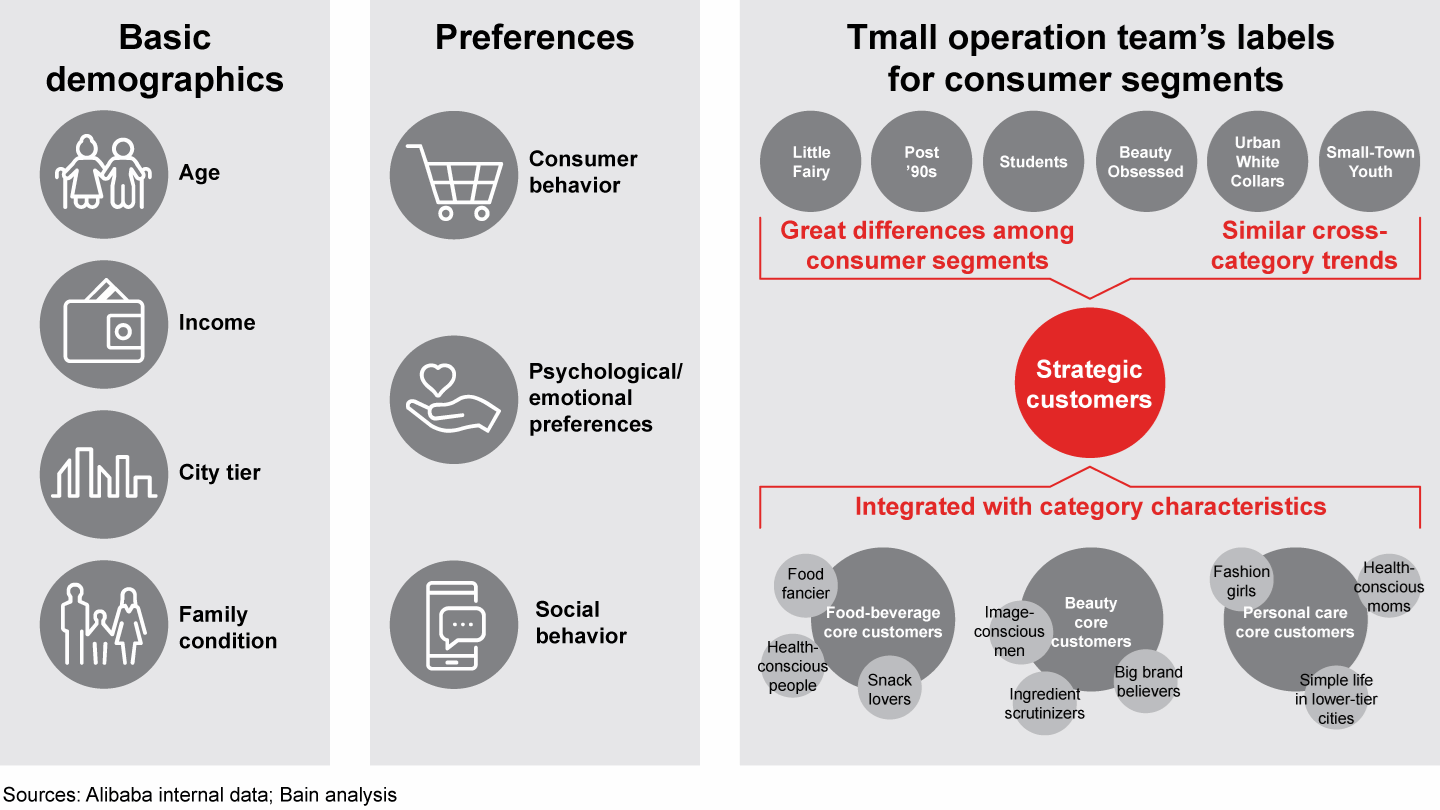
Indeed, the traditional product-centered approach, in which a brand uses a product angle and relies on gross merchandise value as its target, is no longer appropriate. It comes with high consumer-acquisitions costs and the difficulty of building core brands while losing existing consumers. It also does little to help consumer goods companies deal with multiple challenges: intensified industry competition, frequent price wars and the aggressive attack from insurgent brands. A product approach can no longer sustain a brand’s healthy growth. The evolving market dynamic requires brands to move to a consumer-centered operations model. That means embracing deep consumer insights for precise mapping across consumers, products and marketing/promotion channels, and further improving quality and efficiency. Only by taking such an approach can brands reach their full potential and outpace competitors.
For this report, we have drawn key insights from the data produced by hundreds of millions of consumers on the Tmall and Taobao platforms to understand who China’s online shoppers really are, how they behave online and what steps companies can take to win them over. It is the first time that this unparalleled data mine has been made available for systematic analysis.
The main contents of this report include:
- Strategic consumer group definitions. Who are the strategic consumer groups that will be responsible for FMCG growth?
- Strategic consumer preference. What are their preferences in product categories, online shopping touchpoints and communications channels?
- How brands can win. What are the best ways for brands to develop accurate and efficient operations to sell to these strategic consumer groups?
Consumers: strategic consumer groups
Consumer segmentation methodology
Our analysis of the consumption behavior of hundreds of millions of consumers, combined with Tmall's approach to labeling consumers, has led us to identify eight strategic online consumer groups.
Those consumer groups are Rookie White Collars, Wealthy Middle Class, Supermoms, Small-Town Youth, Gen Z, Urban Gray Hairs, Small-Town Mature Crowd and Urban Blue Collars (see Figure 6). Collectively they account for 80% of FMCG platform users and represent over 90% of gross merchandise volume. Let’s look at these groups one-by-one:
Different words describe each of China’s eight strategic consumer segments

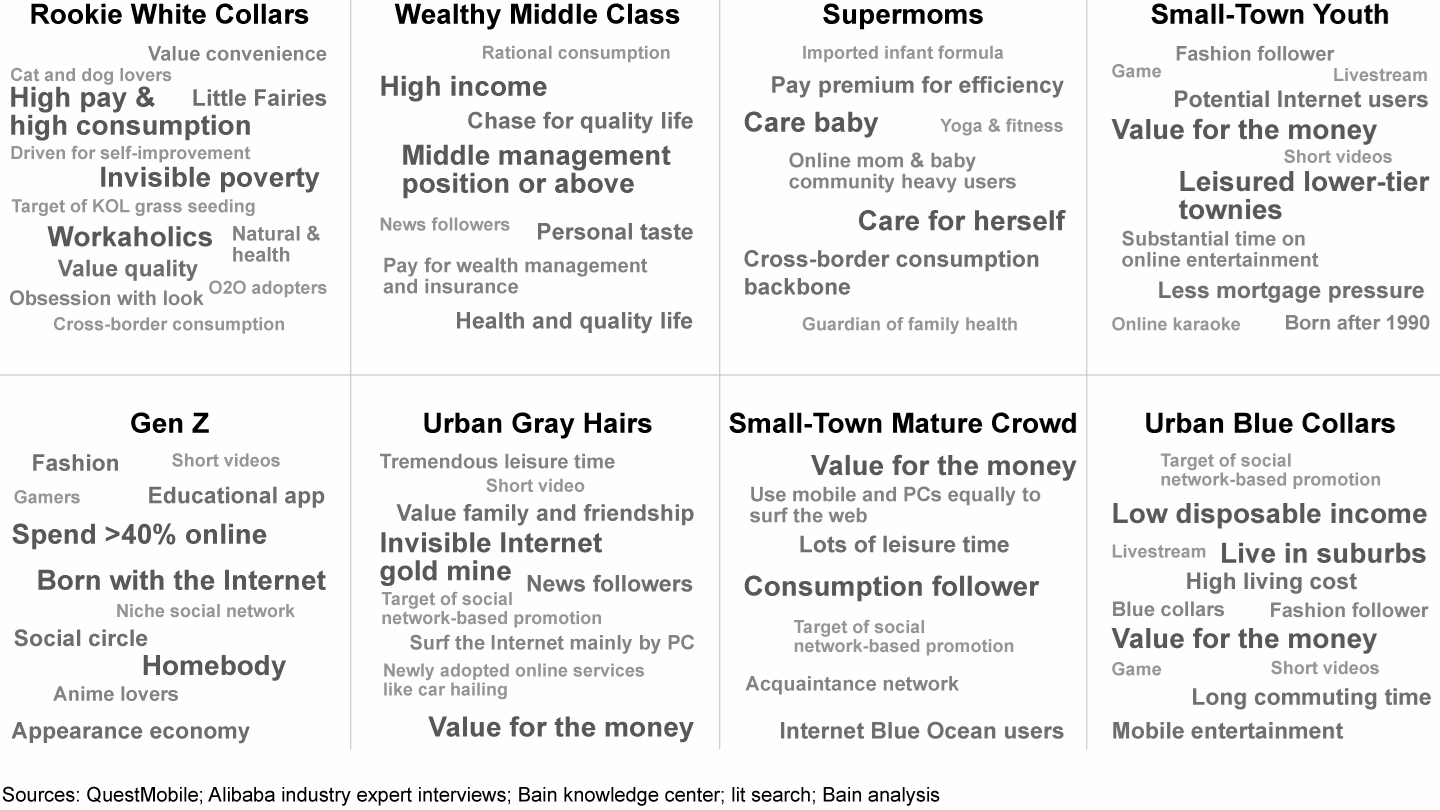
Eight strategic consumer groups
Rookie White Collars are educated people in their early 30s who live in Tier 1–3 cities. Many of them hold positions in corporate staff or work in financial services. Their careers are advancing. They work in a fast-paced environment and greatly value convenience—hence, they prefer online shopping. They represent higher per-capita spending on Tmall and Taobao, with annual spending growth of around 20% from 2016 to 2018. Their willingness to try innovations leads them quickly to shift to new brands. They are passionate about self-improvement. As such, they spend heavily to improve themselves mentally and physically. Despite their healthy income, they may have lower-than-expected disposable income, due to high housing costs and other expenses required to maintain their lifestyle.
Wealthy Middle Class consists of financially stable consumers, typically in their early 40s. They live in Tier 1–3 cities, hold bachelor’s or advanced degrees, and primarily work as civil servants or in corporate middle or senior management. They are less passionate than their younger counterparts when buying the latest new products. As more rational consumers, they value quality, and a higher proportion of their online purchases are premium products. When shopping offline, they value the in-store experience.
Supermoms are women who are pregnant or have children under the age of 12. They live in Tier 1–3 cities and are concerned about raising healthy families while taking great care of their own careers—and their own health and beauty. They are the main shoppers for their families and are willing to pay a premium for convenience. Among all groups, they have the strongest spending power. It is reflected in the number of categories and brands they buy, their shopping frequency and the amount they spend. They value products that promote health and pay special attention to product safety. Their purchasing power influences the premiumization of the categories in which they buy. They also favor high-quality overseas products, such as imported infant formula, which they purchase via cross-border online platforms.
Gen Z consists of students or others born after 1995 and living in Tier 1–3 cities. These consumers are digital natives. They buy everything they can online (70% of this group made more than 40% of their total purchases online) and they are extreme repertoire shoppers. Unlike their older counterparts, they value trendy items over established brands and are major fans of insurgent brands. This group represented the fastest per-capita spending on Tmall and Taobao FMCG, with sales growing 30% annually from 2016 to 2018. They are passionate about self-expression, developing their interests online through sites dedicated to social activities related to niche hobbies and culture. Obsessed with appearance, they are a big force behind the online growth of cosmetics and other beauty categories in China.
Small-Town Youth are consumers in their 20s in Tier 4 or smaller cities. They take their cues from big-city youth, eagerly following the latest urban trends. Without the pressures of exorbitant housing prices, they have considerable disposable income at their fingertips. The slow pace of life also provides them with enough time to enjoy games, video streaming and other online leisure activities. Their income and free time make them a huge potential force in online shopping.
Urban Gray Hairs are consumers born before 1970 who live in Tier 1–3 cities. The majority of them are retired and have substantial pensions. This group could be considered a hidden gold mine for online sellers. They now spend relatively little online. In fact, their per-capita spending dropped 20% annually from 2016 to 2018. However, they could be thoughtfully cultivated as new customers. Unlike younger groups, they tend to be mindful of prices when shopping online and prefer discounted products. They highly value maintaining strong relationships with relatives and friends, preferring simple methods of communication. They are influenced by Pinduoduo, Qutoutiao and other social network apps that enable online sellers rapidly to acquire customers from an existing user base.
Small-Town Mature Crowd consumers are older than 35 and live in Tier 4 or smaller cities. They use mobile phones and computers in equal measure to surf the Internet. With their slow pace of life, they typically have an abundance of time to watch videos or news online. They make most of their purchases offline, a preference that allows them to socialize with acquaintances face-to-face. The Small-Town Mature Crowd registered the lowest per-capita FMCG spending on Tmall and Taobao of any group in 2018. They tend to follow others’ choices when shopping and, like their urban counterparts, are the key targets of social-network-based promotions.
Urban Blue Collars are less affluent consumers in Tier 1–3 cities who are typically engaged in such professions as catering, transportation or retail. These consumers are likely to reside in the suburban areas of those cities and usually spend their long commutes enjoying entertainment on their mobile phones. They are familiar with the same e-commerce infrastructure and online channels that influence their middle-class counterparts. Yet, compared with the Rookie White Collars or Wealthy Middle Class groups, they are more concerned about value for their money when shopping online and tend to buy fewer items. Their per-capita spending on Tmall and Taobao FMCG is far below that of middle class shoppers and grew at a relatively slow 5% rate from 2016 to 2018.
Three consumer clusters
By further analyzing their relative sales contribution and online penetration, we also found that these eight groups fall into three clusters—the triple engine of online sales (see Figure 7). Backbone consumers (Rookie White Collars, Wealthy Middle Class and Supermoms) are the most mature and sophisticated consumer groups. New Power consumers (Small-Town Youth and Gen Z) exhibit the most potential. Blue Ocean consumers (Urban Gray Hairs, Small-Town Mature Crowd and Urban Blue Collars) comprise the most underdeveloped cluster, with the lowest penetration and sales growth. In general, we found the analysis of the eight segments more insightful for brands, but we also found that it was useful, in some cases, to refer to the three clusters.
Backbone, New Power and Blue Ocean shoppers make up the “triple engine” of online shopping

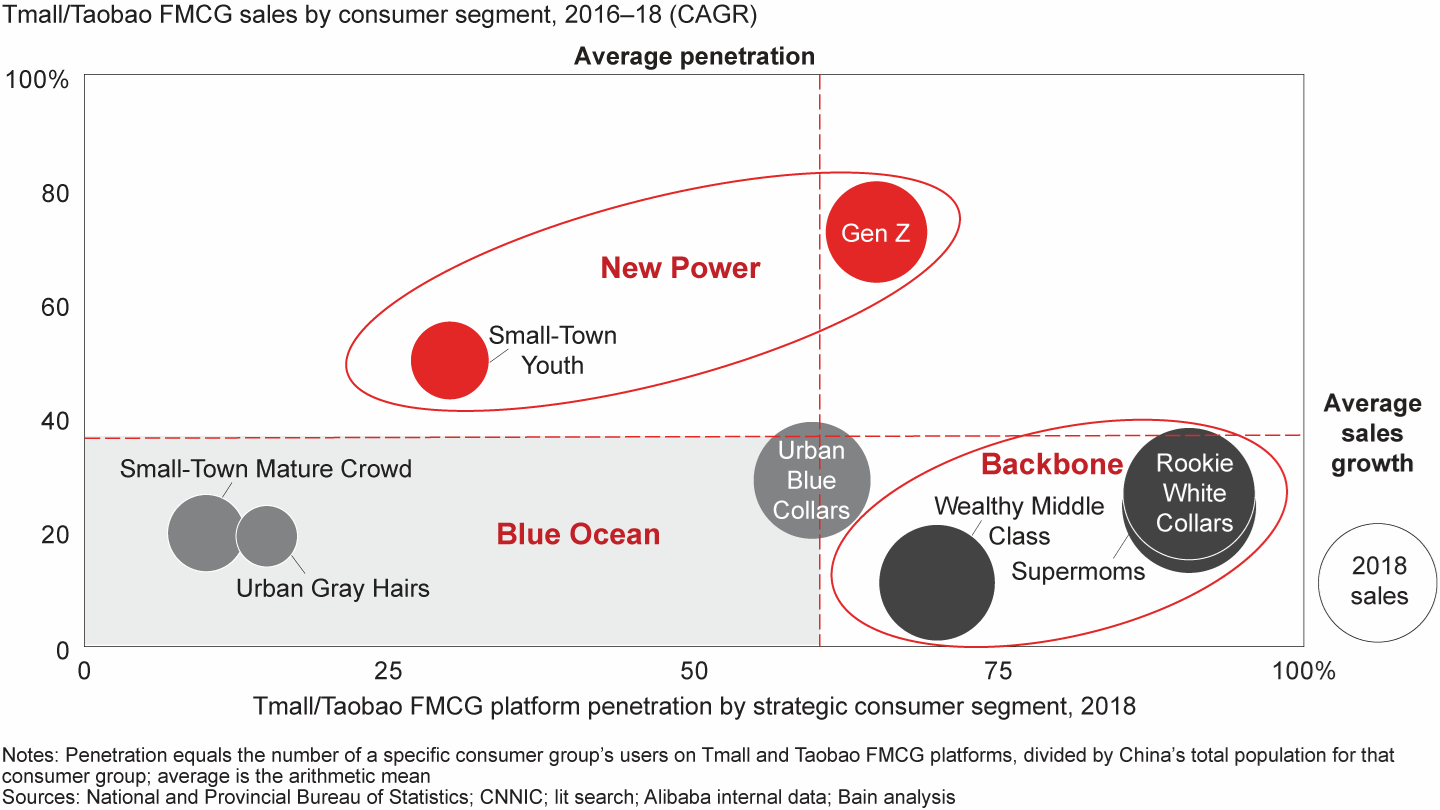
Backbone contributes the most; New Power drives new growth
For consumption per capita, the Backbone cluster is the strongest, with Supermoms (their families’ primary purchasers) exhibiting especially prominent spending power. They not only take on all the needs of their children, but typically also care for parents, all while pursuing their own careers. It is no surprise that the convenient online channel usually is their preferred method of shopping. Consider that Supermoms’ online per-capita consumption is roughly 50% higher than that of Rookie White Collars and Wealthy Middle Class consumers (see Figure 8).
Consumption is highest for Supermoms and growing fastest for younger shoppers; older shoppers are losing momentum

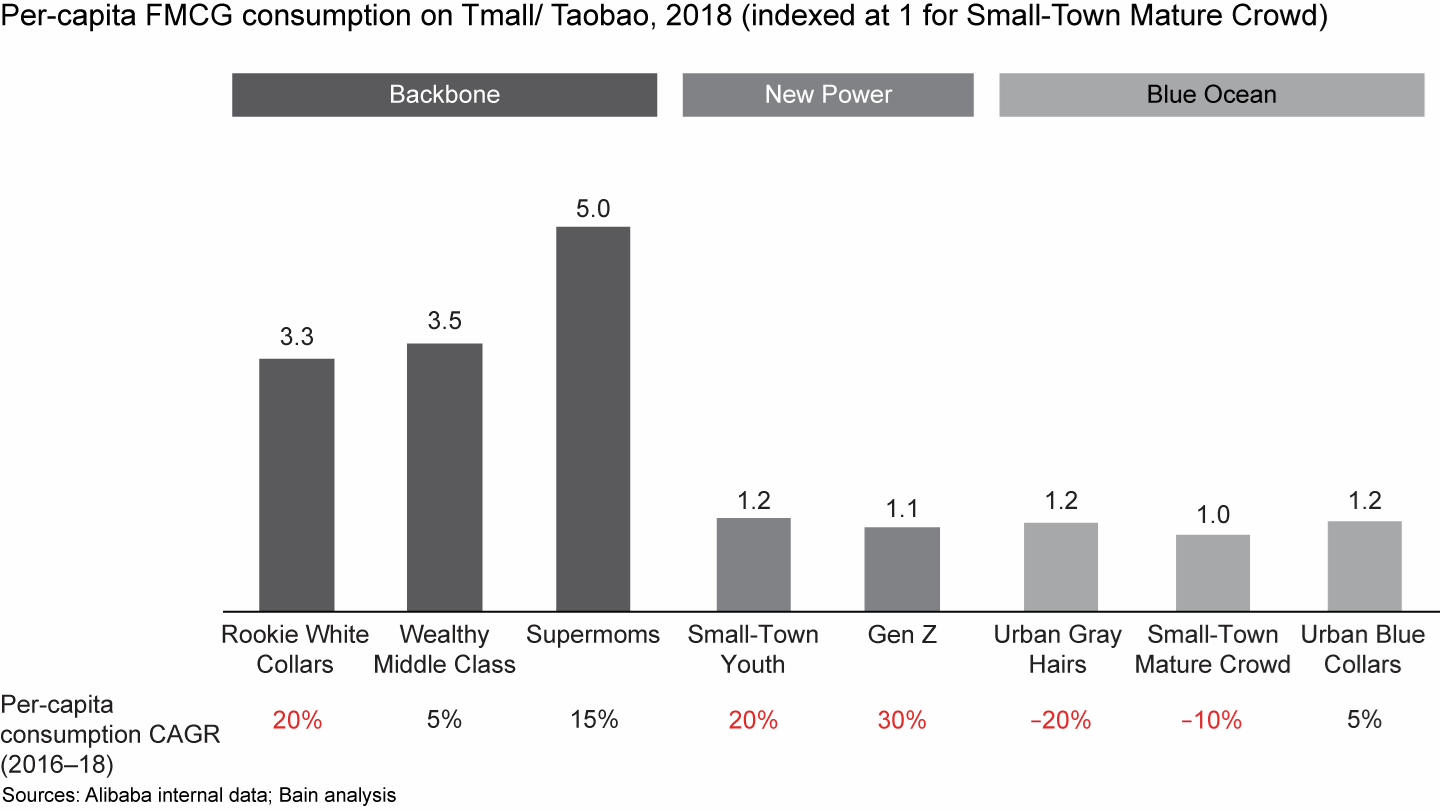
New Power and Blue Ocean consumers only spend about one-quarter to one-third of what Backbone consumers spend online. However, the New Power cluster, with its younger members, shows the most promise for continued rapid growth. For example, online consumption per capita among Generation Z grew by about 30% a year from 2016 to 2018. By contrast, online spending is declining for Blue Ocean consumers. Activating consumption for Blue Ocean consumers can be a priority for brand owners and platforms alike.
Drivers of growth
Growth in online shopping depends on the number of consumers, frequency (average number of transactions) and the value per transaction. With those drivers in mind, New Power consumers emerge as the most vibrant, with very similar growth patterns for Gen Z and Small-Town Youth; they show healthy growth for all three drivers. For example, their consumer base expanded 30% annually from 2016 to 2018, the highest of all three clusters. Growth in the Backbone cluster resulted mainly from increases in value per transaction in beauty and food and beverage (see Figure 9). Value per transaction was especially strong among Rookie White Collars. However, the numbers of Backbone consumers and transactions were stagnant.
The value per transaction is growing for Backbone shoppers, but declining for Blue Ocean shoppers

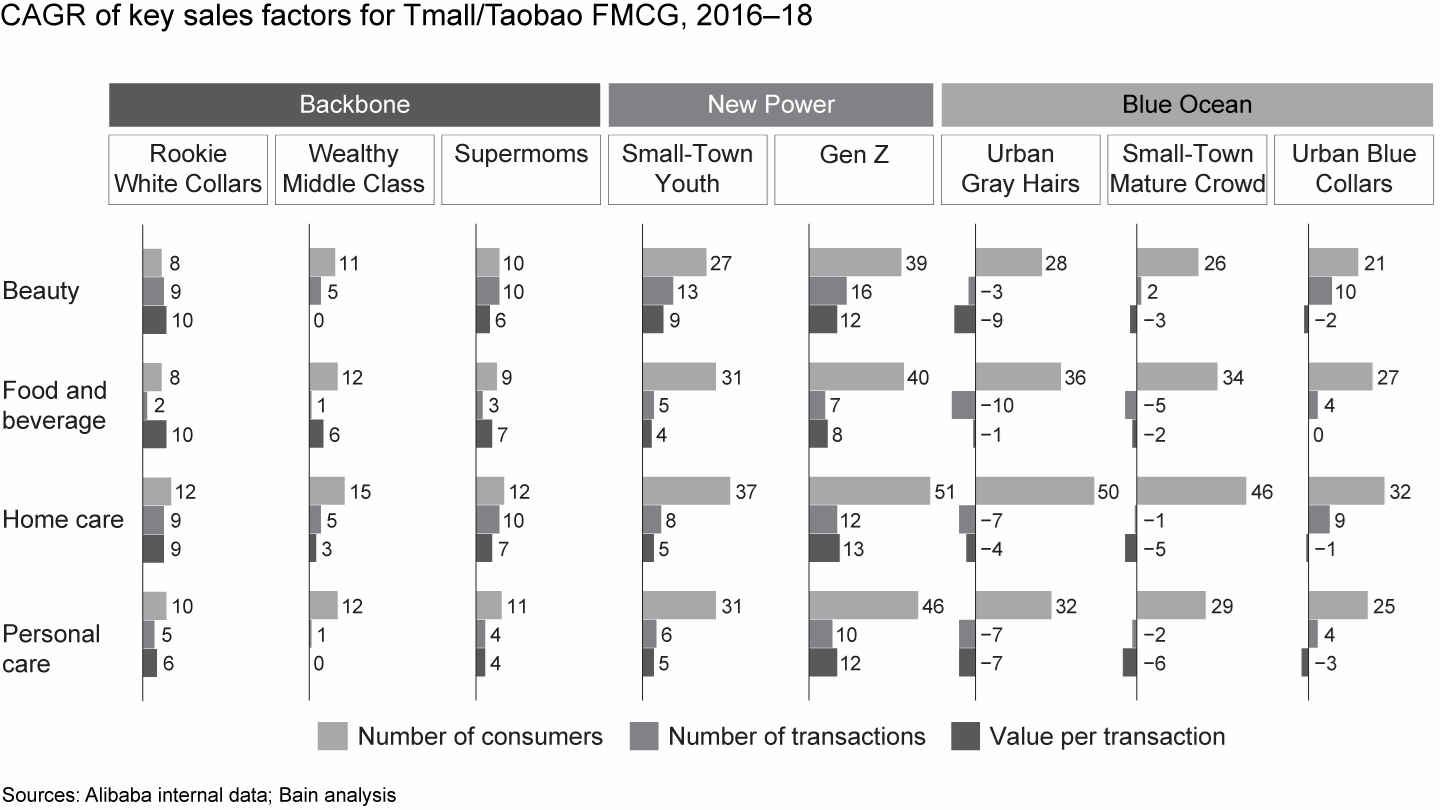
Despite a rapid rise in its population, the Blue Ocean cluster experienced flat or even negative growth in the number of transactions and value per transaction, depending on the category, especially for Urban Gray Hairs and the Small-Town Mature Crowd. Among the possible reasons for this lackluster performance: declining macroeconomic growth, cautious consumption behavior, and competition from new social e-commerce platforms that compete with Tmall and Taobao.
Products: trends in category preference
“Two-speed” paths to premiumization
Consumers are the first battlefield for brands hoping to win online. Products are the second battlefield. Brands need to use the consumer prism to understand how their target consumers influence a host of critical product trends.
In our continuing China Shopper Report series, we have examined the dimensions of China’s phenomenon of two-speed growth among product categories. Some categories have consistently achieved healthy growth, while others have grown much more slowly. This two-speed growth scenario holds true in online sales among consumer segments. Young consumers, especially Gen Z and Rookie White Collars, lead the premiumization trend. By comparison, Urban Gray Hairs, the Small-Town Mature Crowd and Urban Blue Collars are trading down.
Our research found that premiumization is most evident in the beauty category (see Figure 10). An increasing emphasis on personal appearance across all consumer groups has led to an expanding share for mid- to ultrapremium beauty products. Rookie White Collars are especially eager and able to invest in their appearance. As a group, their share of mid- to ultrapremium products rose by 8 percentage points from 2016 to 2018. Gen Z and Small-Town Youth were close. Both groups saw 7% share gains for those higher-priced products. These findings highlight how younger consumers are willing to pay for premium beauty products. Winning brands are taking this trend to heart by improving their product assortment to cater to younger consumers in search of premium beauty brands.
Backbone and New Power shoppers contribute the most to premiumization

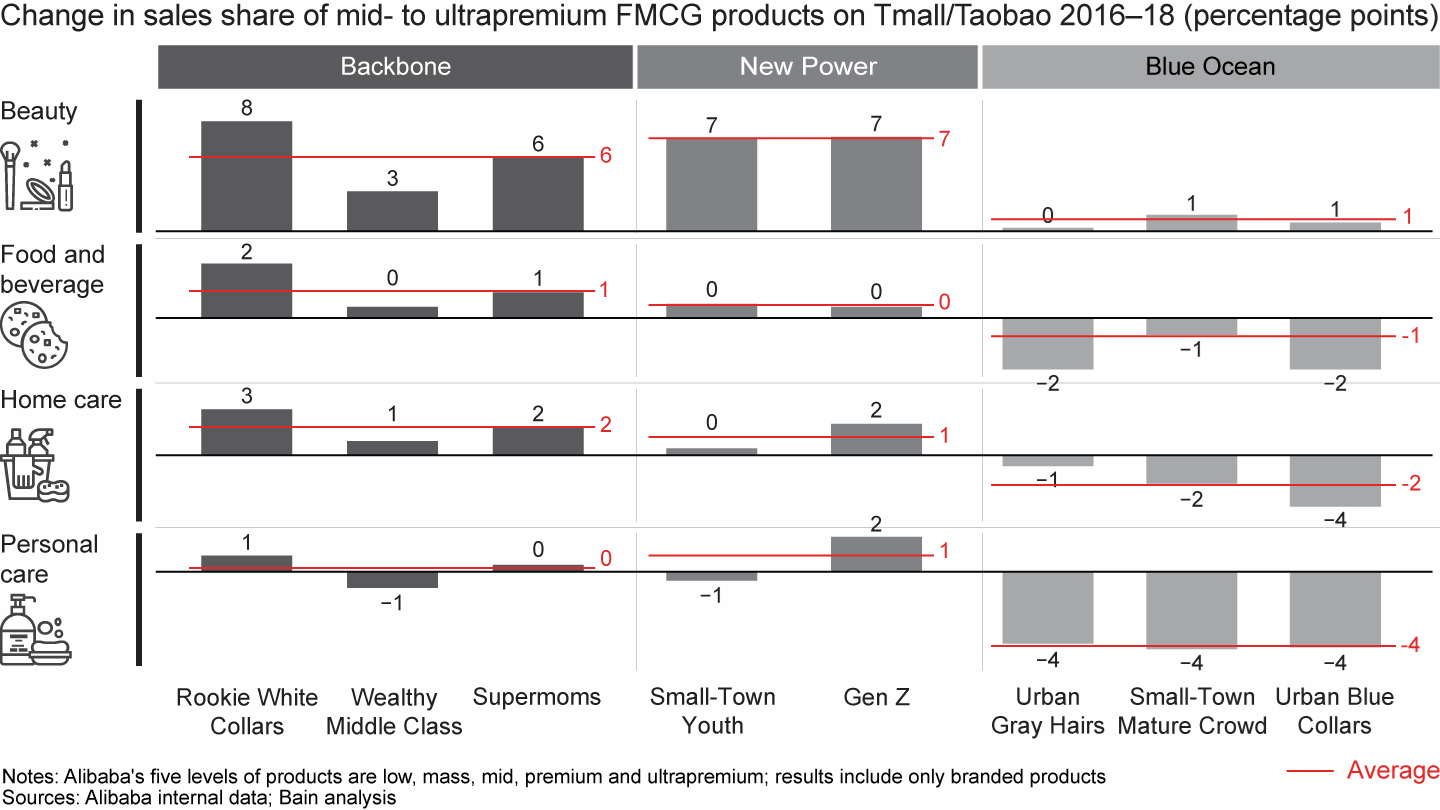
Backbone and New Power consumers alike have a growing share of mid- to ultrapremium products in almost all product categories. Among them, Rookie White Collars and Gen Z witnessed the largest share increase in home care and personal care. By contrast, Urban Gray Hairs, Small-Town Mature Crowd and Urban Blue Collar consumers bought fewer mid- to ultrapremium products in all categories except beauty.
Brand diversity: Small-Town Youth, Gen Z and beauty take the lead
The more sophisticated consumers become, the more brands they buy. Among all consumer groups, Gen Z and Small-Town Youth are the most willing to expand into new brands across all categories (see Figure 11). With their appetite for the latest fashion and their preference for social media, these younger consumers easily gravitate toward new categories and brands. Consider that Gen Z consumers bought 23% more brands annually in 2016 to 2018. By contrast, Urban Gray Hairs, Small-Town Mature Crowd and Urban Blue Collars consumers buy fewer and fewer brands.
New Power consumers lead in growth for the number of brands purchased

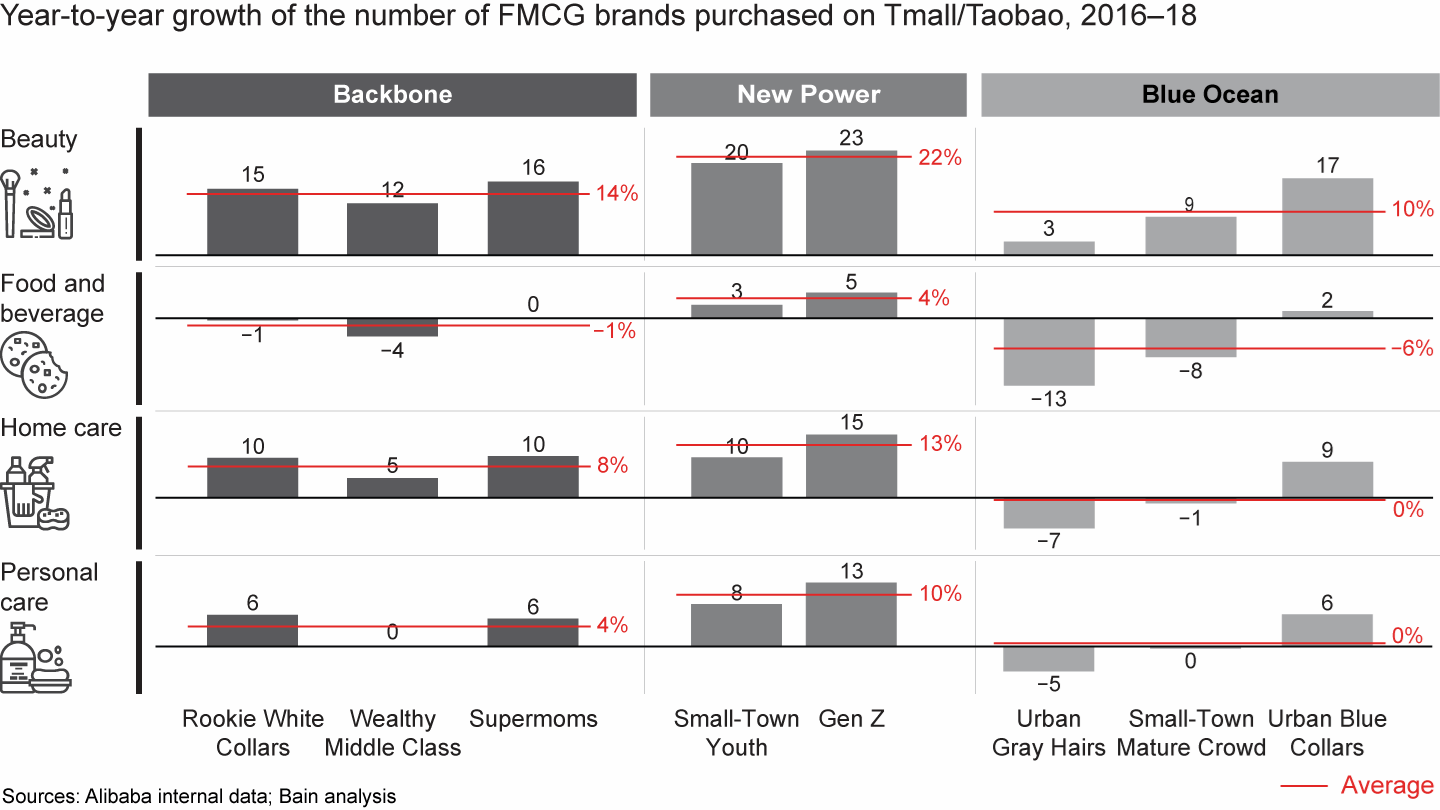
Beauty was the only product category in which these three consumer groups bought more brands from 2016 to 2018. One of the takeaways from this finding: beauty is a typical repertoire category in which consumers show relatively little loyalty. In this “leaky bucket” category, brands continuously need to attract consumers to replace those who decide to buy competitors’ products. But the prevalence of repertoire behavior also means that there is ample room for new brands to grow and flourish.
Insurgent brands on the rise
Young insurgent brands are everywhere today—and they are quickly reshaping the online market, even to the point of finding a place among the top 50 brands. In fact, depending on the category, five to seven of the 2018 top 50 brands were launched on Tmall after 2016. The phenomenon raises challenges for incumbent brands, but opens opportunities for new brands. Our research found that Supermoms, Rookie White Collars and Gen Z consumers are the most welcoming to insurgent brands across most major categories (see Figure 12). These buyers also are the most digitally savvy among consumer groups and actively seek recommendations on social media and from trustworthy key opinion leaders.
Beauty is the most dynamic category for insurgent brands, thanks to Backbone and New Power consumers

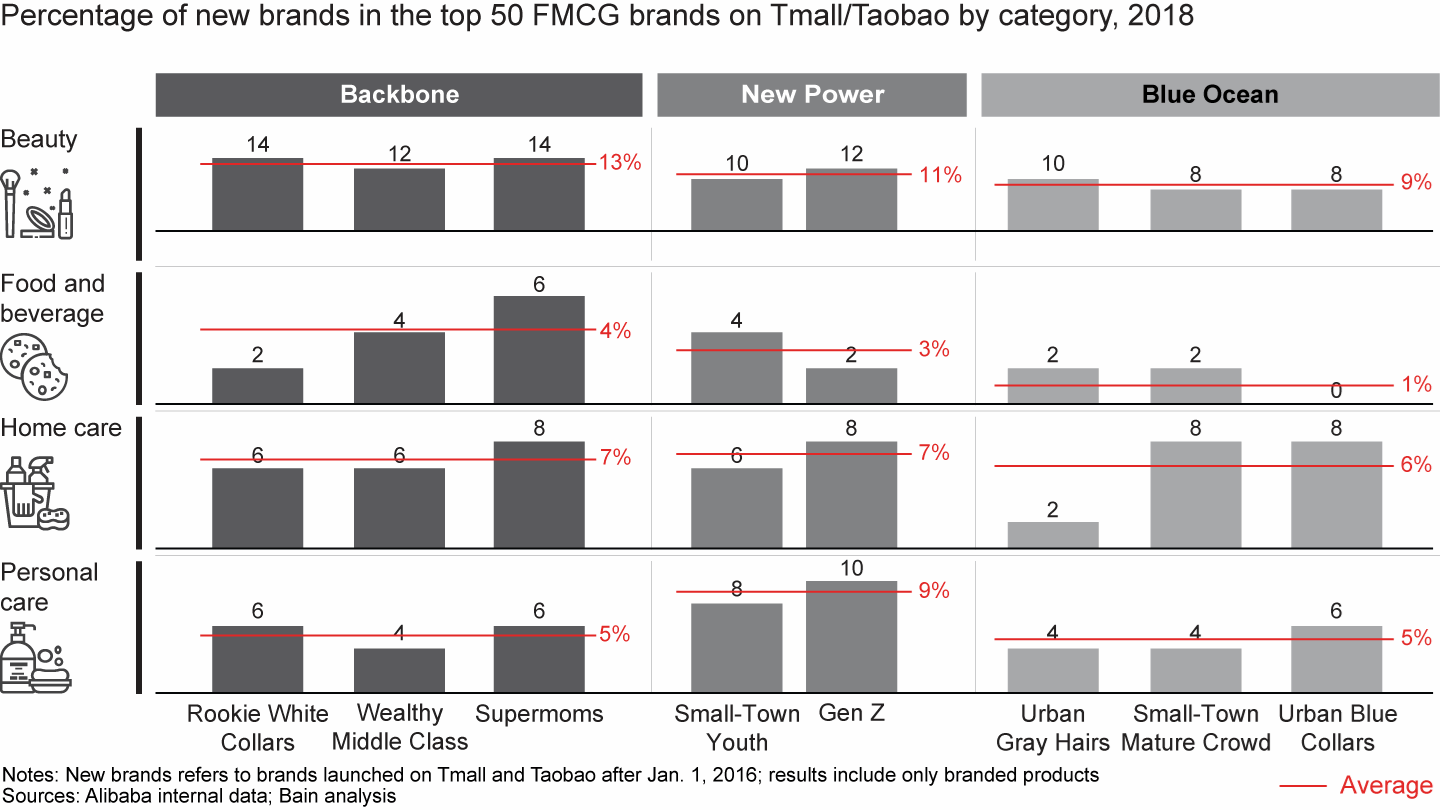
The beauty category has emerged as a key arena for insurgent brands. Social e-commerce and cross-border e-commerce unlock opportunities for beauty insurgent brands to grow in China, thanks to suitable channel economics and more efficient route-to-market opportunities. Taking a closer look at insurgent brands within the top 50, we find that Gen Z consumers prefer local brands, while Rookie White Collars clearly prefer foreign brands. The majority of Gen Z’s new beauty brands in 2018’s top 50 are local (Perfect Diary, Home Facial Pro, Winona, etc.). Local beauty brands offer a better value-for-the-money proposition and have nimbler organizations that can quickly react to changing consumer needs. They can rely on brand incubation centers and test-and-learn capabilities to introduce new brands catering to Gen Z consumers’ evolving tastes. The foreign insurgent brands preferred by Rookie White Collars succeed in part by capitalizing on such trends as aesthetic medicine and home medical treatments.
Rapid category expansion
Younger online shoppers, especially Gen Z consumers, are willing to buy from more categories (see Figure 13). For example, they have boosted penetration by an average 13 percentage points in the top 10 beauty subcategories such as color cosmetics and fair-priced skin care.² While Rookie White Collars increased their penetration of the top 10 beauty subcategories by only 4 percentage points, they show a preference for more sophisticated subcategories such as facial essences and makeup tools.
Gen Z has increased its purchases of beauty products the most of any group, while Rookie White Collars are expanding into more sophisticated subcategories

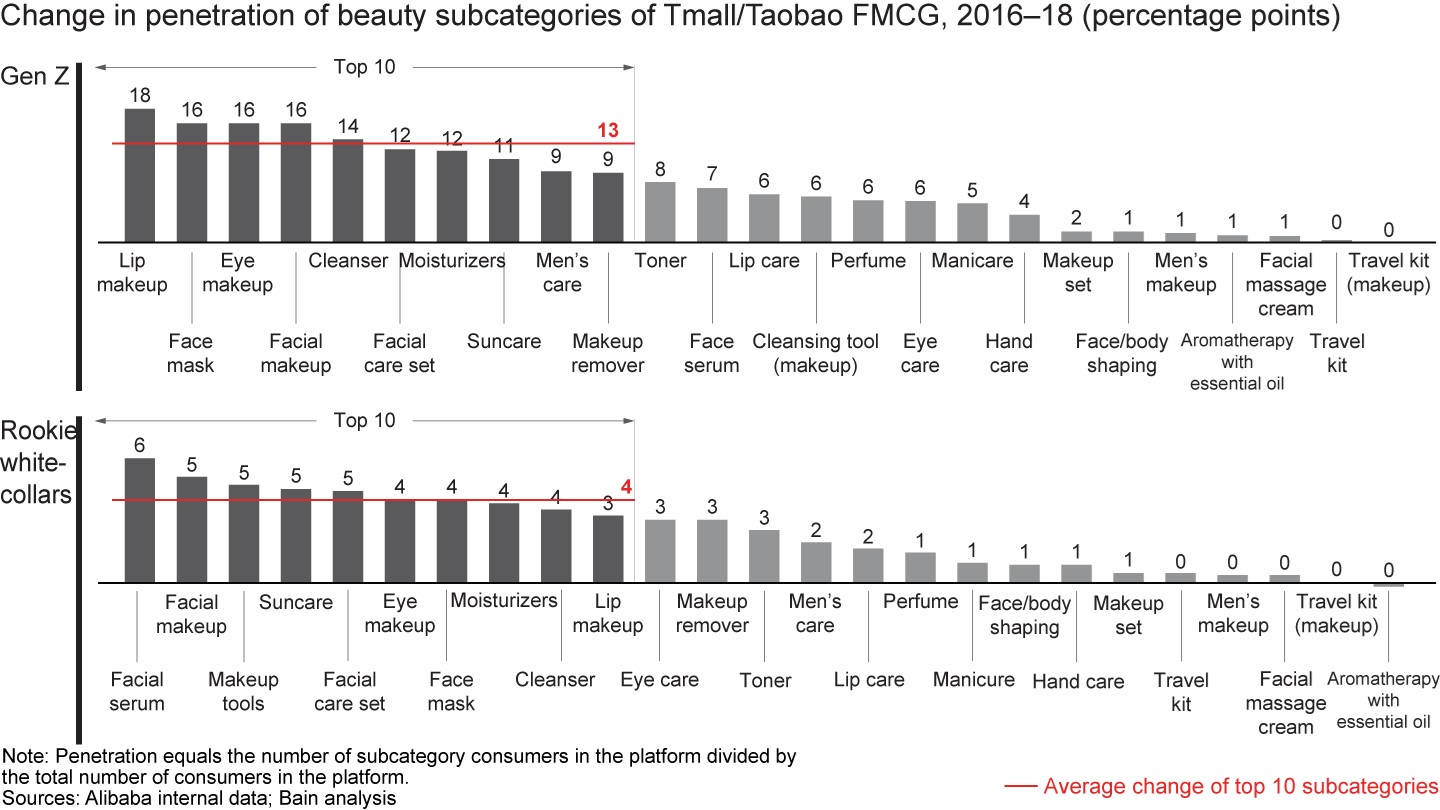
Winning brands: local vs. foreign
The foreign vs. local battle rages on. While foreign brands managed to maintain share in most product categories, they lost share to local brands in the beauty and food and beverage categories (see Figure 14). Foreign brands lost 7 percentage points of value share to their Chinese counterparts in color cosmetics, for example. Meanwhile, consumers’ increasing needs for premium products helped foreign brands gain share from local brands in many home care and personal care categories. Foreign brands can benefit from the trend among Chinese consumers to buy more premium products by adding more of those products to their portfolio.
Foreign brands are losing share to Chinese brands in the beauty and food-and-beverage categories, but maintaining share in others

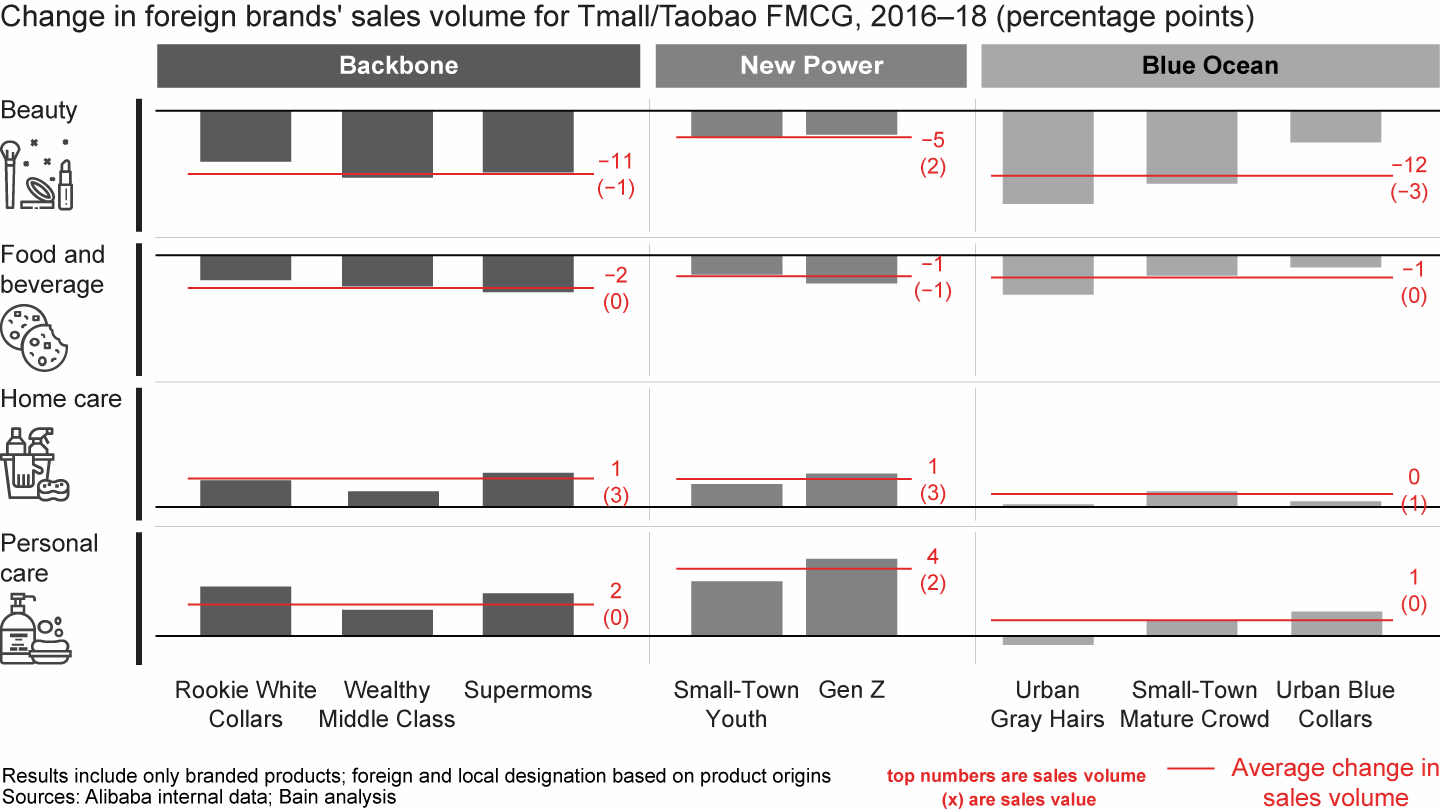
Foreign brands are quickly learning what it takes to win in China. It requires keeping pace with the market’s rapid changes and a “4D” approach: design for China, decide in China, deliver at China speed and digitalize the China business (see the Bain Brief “Consumer Products: Now’s the Time to Double Down on China”).
Big brands win online
Overall, the top 50 brands gained market share for food and beverages, home care and personal care. Only in the beauty category did they lose share (see Figure 15). Big brands typically have a competitive advantage in digital marketing investments and in frontline expertise that takes years to build. However, the current share gains do not mean that big brands always win. Their market share is declining in the beauty category, where established companies face competition from young brands on the rise. This is particularly true in subcategories such as color cosmetics, perfume and men’s care. All have become more repertoire in the past two years with the emergence of new brands. Online and cross-border e-commerce have helped lower the barrier to entry for many brands, including niche foreign brands. Digital capabilities allow them directly to target consumers instead of spending years building out an extensive distribution network.
Big brands’ market share declined slightly for beauty, but was steady in other categories

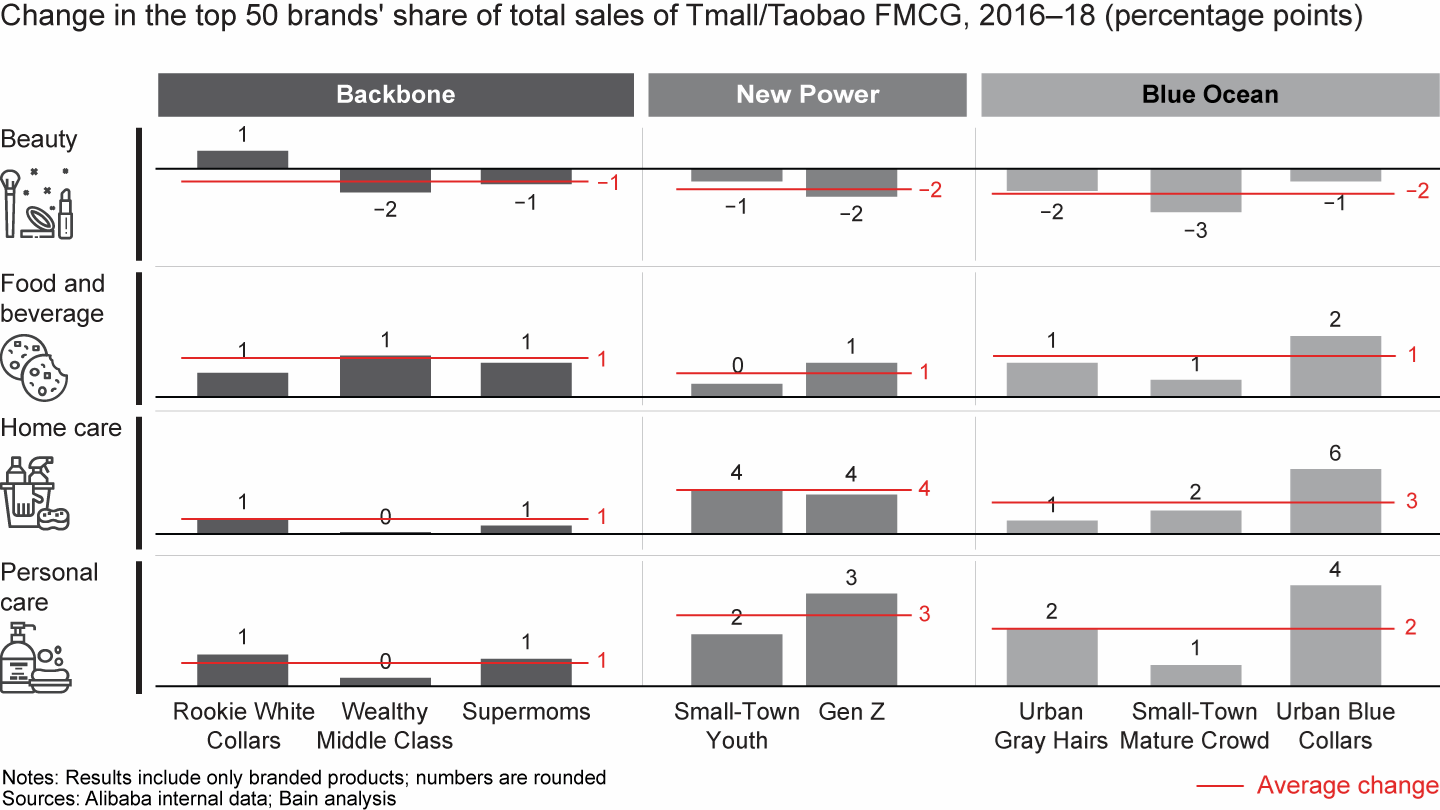
Brand communication: online preferences
The online search paths taken by different consumer groups vary dramatically. For example, Gen Z consumers use words that describe their basic needs (see Figure 16). When searching for facial mask products, they rely on such terms as “pore cleansing” or “moisturizing.” Also, because they have weaker brand preferences, they tend to search fewer names. They are mostly looking for lower-priced new local brands such as One Leaf or overseas niche brands like Ray. By comparison, Rookie White Collars’ searches mirror their growing sophistication. They search for specific brands based on country of origin (Japan and Korea) and ingredients (pearl powder and hyaluronic acid). They favor mid- to high-end brands.
Different consumer groups take significantly varied search paths, requiring differentiated brand communication strategies

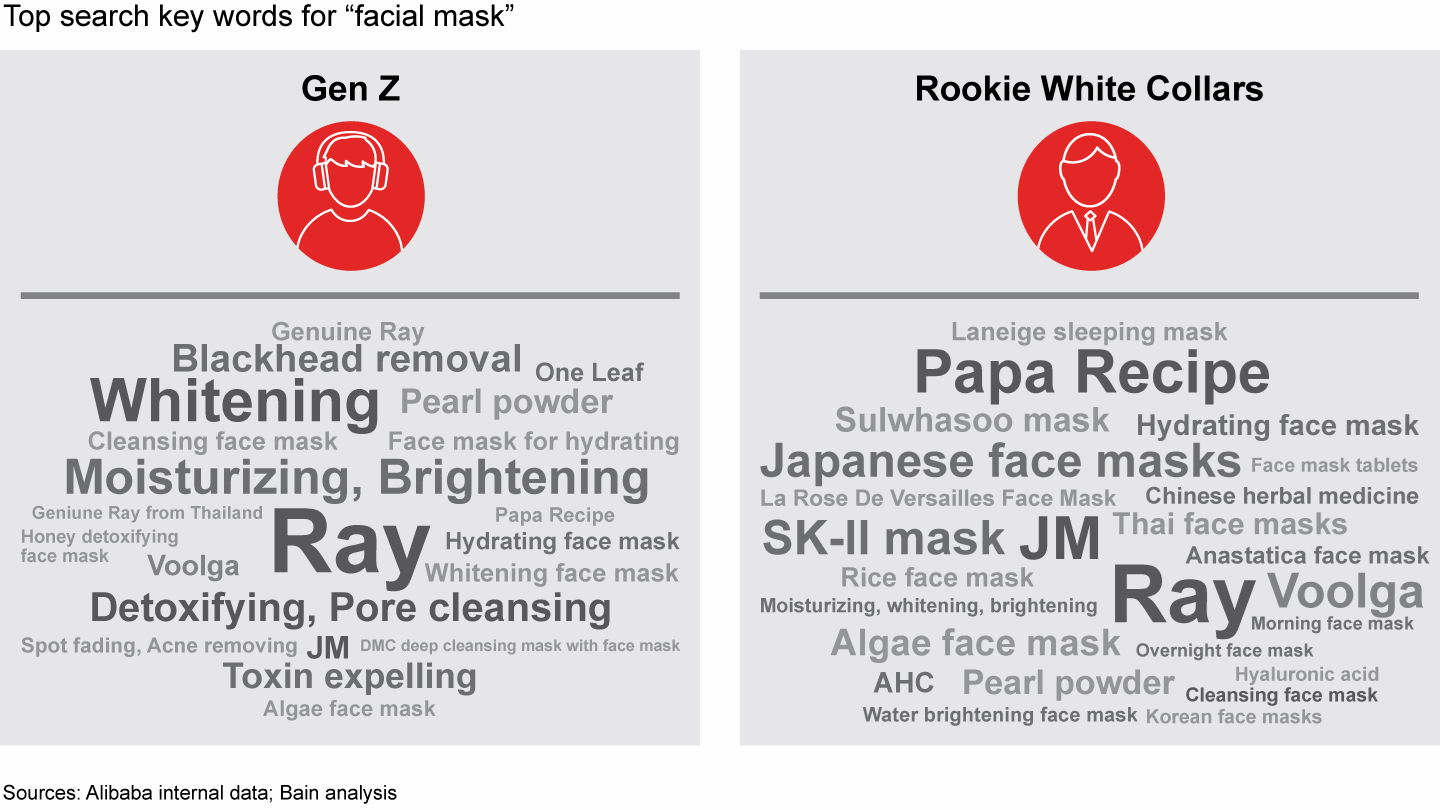
Marketing and promotions: different channels for different consumers
Diversified online marketing channels
Marketing and promotions is the third online battlefield for brands hoping to achieve their full potential in e-commerce. Again, a consumer prism is essential. Winning starts by acknowledging that all consumer groups engage differently with brands.
Tmall and Taobao provide a wide range of content/promotion channels to engage consumers online (see Figure 17).
Tmall and Taobao provide a wide range of content and promotion channels to help brands engage consumers

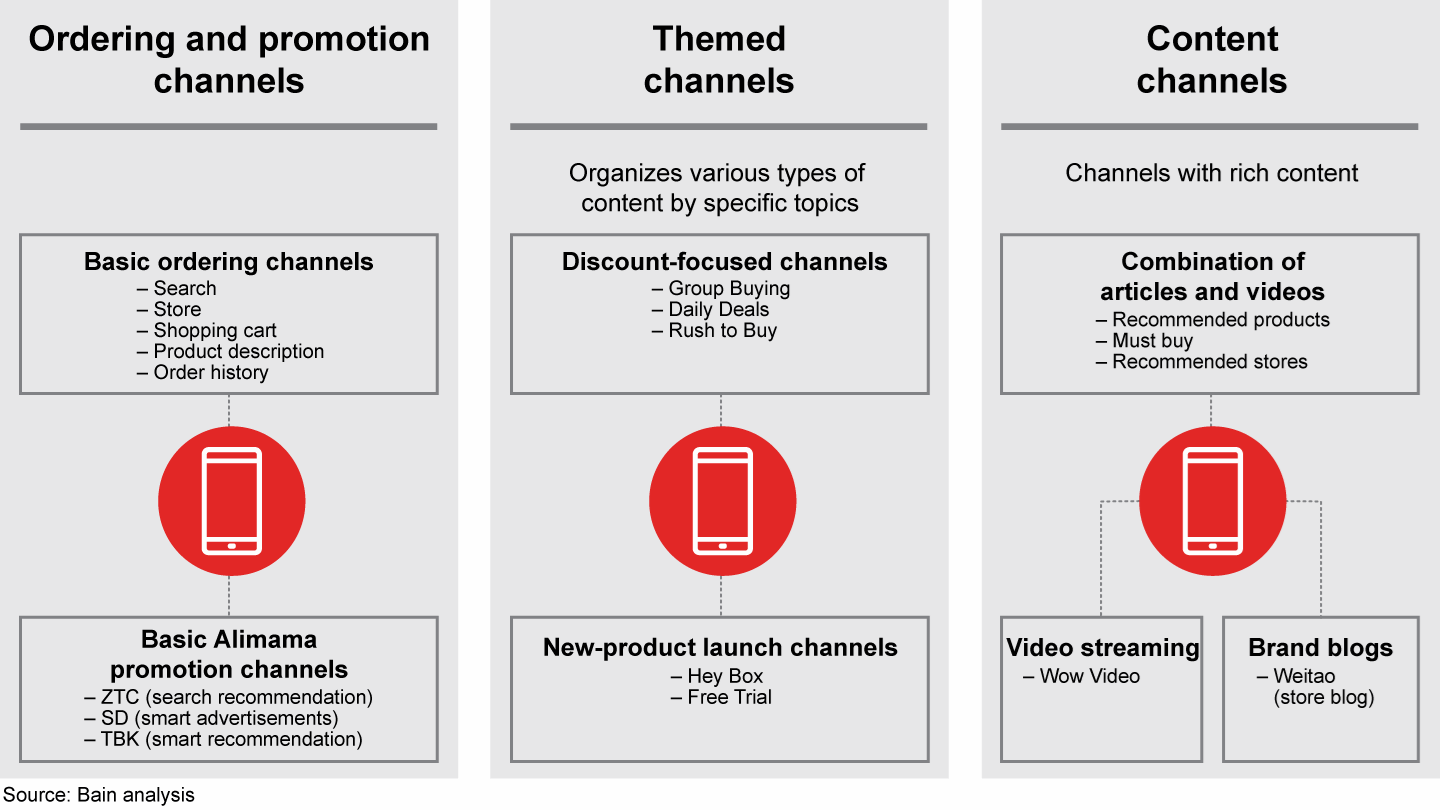
- Ordering and promotion. On ordering channels, consumers place orders through a shopping cart, store page or other channels. Promotion channels are Alibaba-paid marketing tools such as ZTC (smart search key words), TBK (advertisers marketing products through external bloggers, website publishers or apps to increase traffic) and SD (smart advertising).
- Content channels. These are major content channels for live streaming, smart recommendation for products, Weitao (store blog) and smart recommendation for stores.
- Themed channels. These are channels with specific themes such as discount and new-product-focused channels.
Basic ordering and promotion channels
Among the eight basic ordering and promotion channels, there is no overlap between the top three favored by Backbone consumers (shopping cart, store and order history) and those preferred by New Power and Blue Ocean consumers (search, TBK, ZTC). Backbone shoppers are more sophisticated and tend to know in advance what they want (see Figure 18). As a result, marketing tools influence them less than other online shoppers. They place orders directly from their shopping cart, store and order history. Store channels, mainly contributed from flagship and C2C stores, are preferred by Backbone consumers, demonstrating that cluster’s strong recognition and loyalty toward brands and key opinion leaders. Meanwhile, the large share of previous orders reveals Backbone’s strong propensity for repeat purchases.
The top three ordering and promotion channels for Backbone shoppers do not overlap with those favored by New Power and Blue Ocean consumers

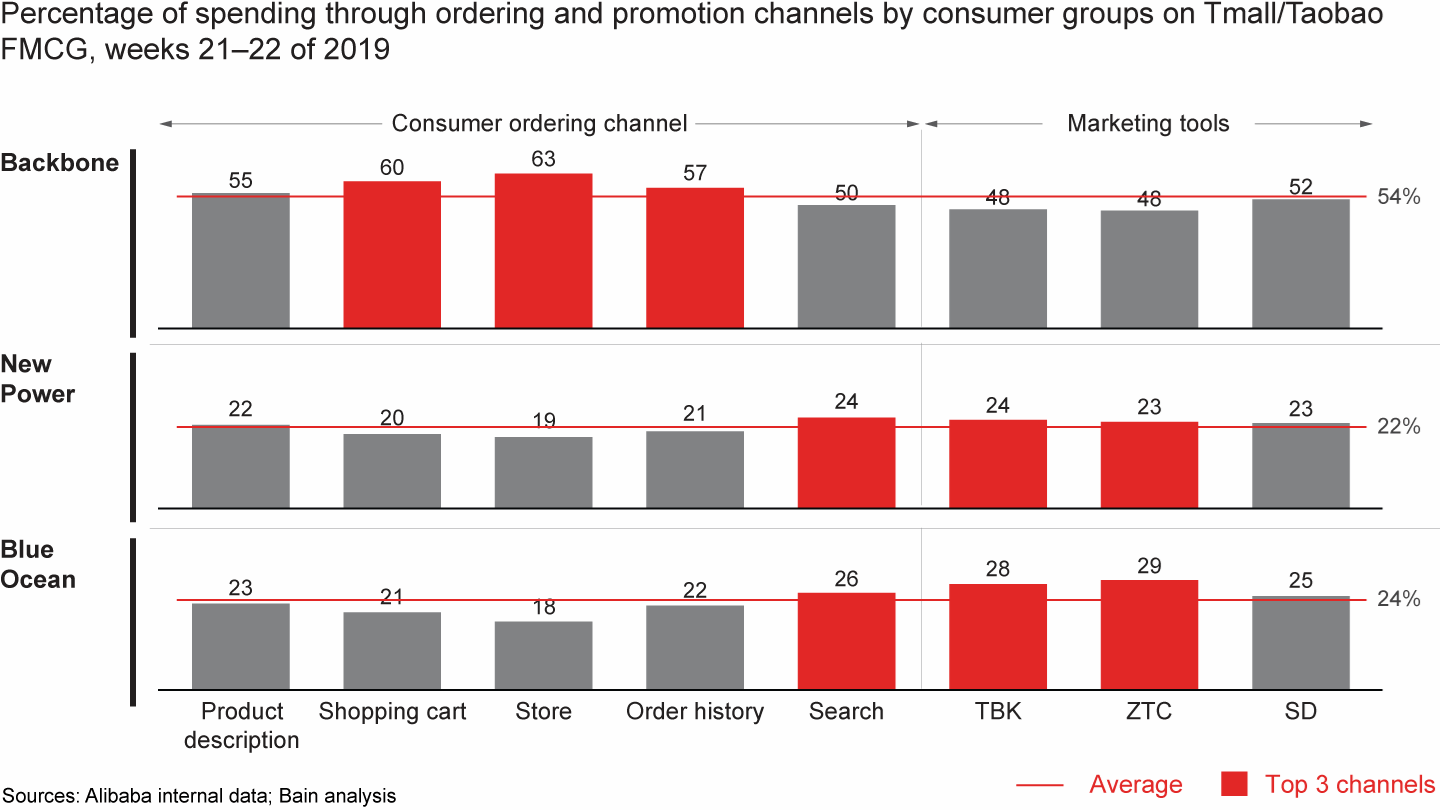
The story is completely different with New Power and Blue Ocean consumers, who make more purchases via marketing tools. These consumers like to explore and browse online without a specific purpose in mind. They are more easily influenced by ads and recommendations. However, there is a disparity between the behavior of young and older consumers in these clusters. For example, younger online shoppers rely more on TBK. For brands selling to young consumers, two effective approaches are what we call “grass seeding” (triggering consumers’ interests outside the Taobao platform) and “harvesting” (in which consumers purchase products inside Taobao).
Finding the right content channel
Backbone consumers account for the most sales on each content channel (see Figure 19). Among those consumers, Supermoms spend the most as they search for the best products to buy. However, each consumer cluster has its own preference. For example, New Power consumers prefer buying on store blogs, where their share of spending is the highest among all four categories. New Power shoppers’ interest in Taobao live streaming is significantly lower than it is for other external apps and websites such as TikTok. Aiming for the New Power live-streaming audience on Tmall/Taobao, pioneers may serve these consumers’ unsatisfied needs and deepen user engagement by enriching live-streaming content. For their part, Blue Ocean consumers—especially Urban Blue Collars—prefer store recommendation.
Backbone consumers are the major contributors to each content platform

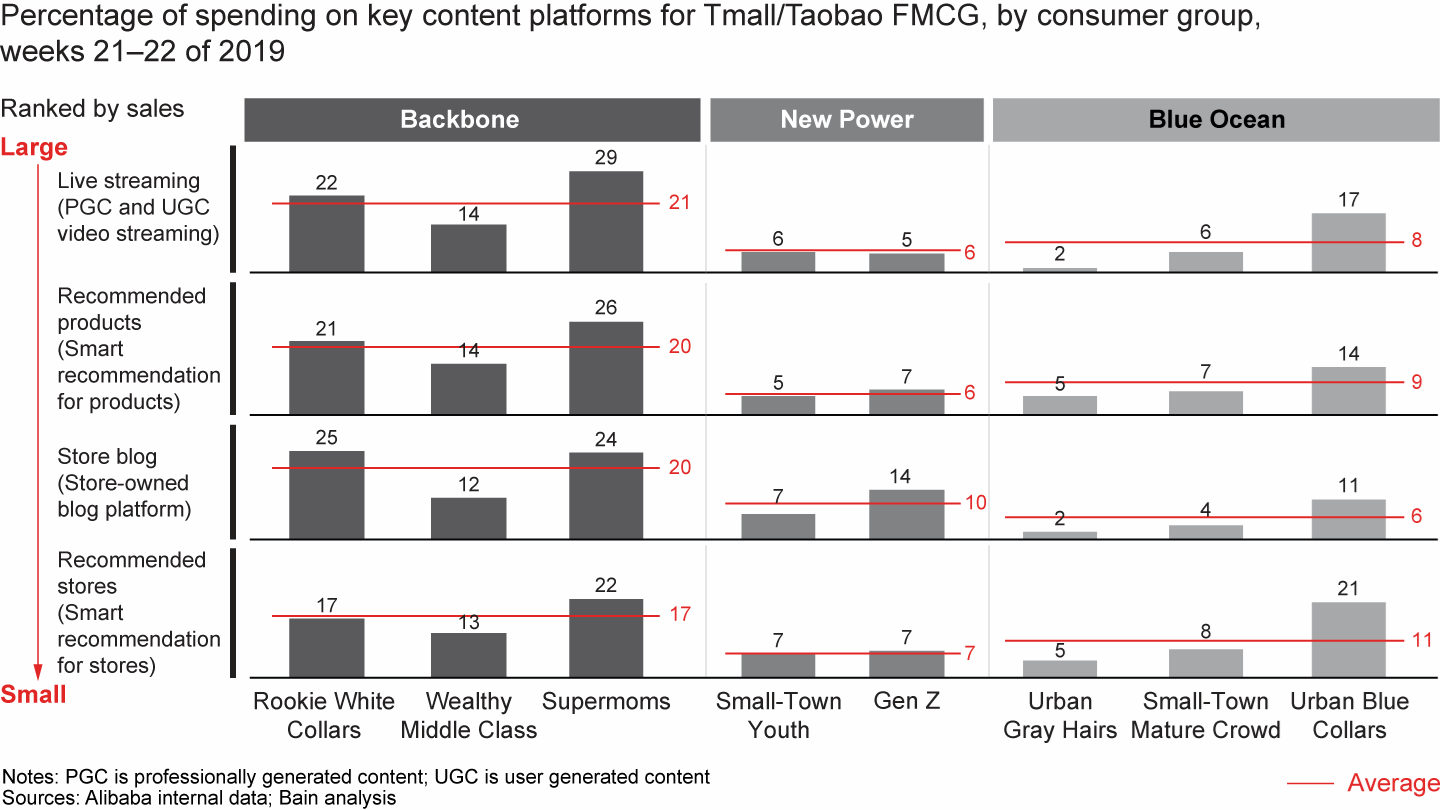
Attractiveness of discount and new-product channels
Discount channels are where Blue Ocean consumers spend their money. Their share of spending in these channels is significantly higher than it is on other content channels. During a two-week period this year, Blue Ocean shoppers accounted for 32% of discount channel sales, and their share of discount channel sales is about 15 percentage points higher than it is for content channels (see Figure 20). New Power shoppers accounted for 18% of discount channel sales, and their share is about 6 percentage points higher than it is for content channels, showing how value-for-the-money is also attractive for that cluster.
New Power and Blue Ocean consumers spend more on discount channels than on other channels

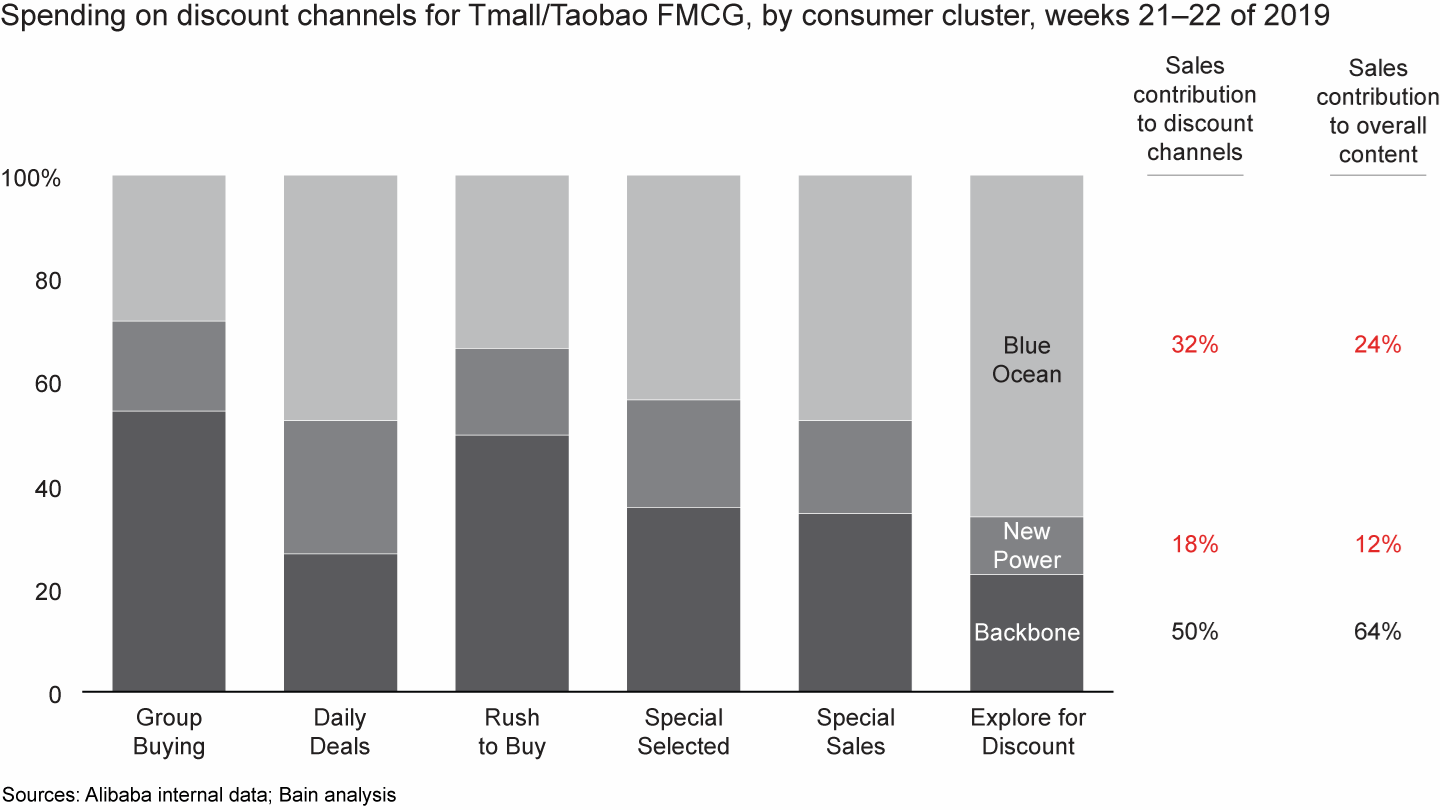
New-product channels such as Free Trial (which offers samples to attract first-time users) and Hey Box (a new-product launch channel) are extremely popular among New Power consumers, who represent more than 40% of overall traffic. That share is highest in Hey Box, where New Power shoppers make up around 60% of the traffic, far exceeding the activity among Backbone consumers. Further evidence that New Power shoppers thirst for new products: they are big fans of Tmall flagship stores, frequently the official launch site for new products. As Tmall flagship stores evolve, brands looking for a competitive edge will target this group with new products, while also improving flagship store operations.
The consumption behavior is clear and distinct among the consumer groups and clusters. Knowing what these consumers buy and how they shop is a first giant step. Brands need to use that understanding—that consumer prism—to guide their investments in the channels favored by targeted consumers, while enhancing the consumer experience throughout the shopping journey.
How brands can win
Winning online means adopting a consumer-centered mindset and regarding strategic consumer groups as the cornerstone for competitive strategy.Brands can follow a four-step process for turning that strategy into action.
Step 1. Clearly understand the targeted strategic consumer groups and their preferences in products and content/promotion channels
There is no “one-size-fits-all” standard of strategic consumer group segmentation that applies for all brands. In fact, segmentation widely varies for different product categories and subcategories. Brands should make use of the massive data sets available to systematically and accurately classify their unique strategic consumer groups. For example, strategic consumers in the infant formula category can be segmented according to roles, such as different types of parents and grandparents, as well as various occasions, such as self-indulgence and gifts to friends. Furthermore, a brand needs to analyze both its own strategic positioning and the industry landscape before determining its targeted strategic consumer groups.
Step 2. Identify key growth drivers to customize a category- and brand-specific strategy
After identifying the strategic consumer groups, brands need to look at three measures: penetration (number of consumers who buy the brand), repurchasing (consumption frequency) and premiumization (average value per transaction). This enables them to identify the growth drivers for key strategic consumer groups and empowers companies to create a customized category and brand strategy (see Figure 1).
In home care, we identified the top five contributors to sales growth in 2016 to 2018: Rookie White Collars, Urban Blue Collars, Supermoms, Gen Z and the Wealthy Middle Class. Combined, these five consumer groups represented more than 70% of the sales growth in home care categories.
When we closely examine the data, we see that penetration, repurchasing and premiumization among Rookie White Collars and Supermoms maintained healthy growth, indicating that brands can further acquire new consumers, foster consumer loyalty and drive premiumization in these two consumer groups.
Meanwhile, penetration improvement plays a big role in increasing sales growth among Gen Z, the Wealthy Middle Class and especially Urban Blue Collars. Brands can adapt their product portfolios (introduce high-value-for-the-money products for Urban Blue Collars or innovative products that highlight emotional propositions for Gen Z) and use specific marketing tools that have higher conversion rates among Urban Blue Collars and Gen Z to attract new consumers efficiently. However, among these three consumer groups, repurchasing and premiumization has a limited influence on sales—in fact, average value per transaction declined for Urban Blue Collars. Brands should consider ways to activate repurchasing and trading up.
Step 3. Optimize product portfolios, marketing and channel strategy—choosing key growth initiatives for reaching and converting targeted consumers
Based on their precise analysis of growth drivers for strategic consumer groups, brands can optimize their product portfolios and marketing and channel strategies to reach and convert consumers more efficiently.
Companies can pursue the eight strategic segments by taking these steps.
- Improve product-consumer matching. Continuously optimize the product portfolio to match consumer needs for product functions, price and specifications. For example, as Backbone consumers focus on the ingredients of skin care products and premiumization, beauty brands should continuously encourage trading up by strengthening the premium products in their brand portfolio, developing high-value and personalized products, and embracing new technologies and leading intellectual property to activate incumbent brands.
- Optimize marketing investment. Comprehensively evaluate how marketing tools influence the end-to-end consumer journey in terms of brand and product granularity, and enhance capabilities and investment in related marketing tools to meet the demands of strategic consumer groups. For instance, young people look for key opinion leaders’ recommendations for new products and promotions. Brands can embrace those opinion leaders and invest heavily in popular content channels like the Weitao store blog, a favorite of young consumers, to maximize marketing ROI.
- Optimize channel portfolio. Give full play to the greatest advantages of different channels and make them complement each other. For online channels, brands can position flagship stores as their main platform for branding, new-product launches and consumer education interaction. They can position C2C stores to test insurgent and niche brands as platforms where they can cooperate better with key opinion leaders.
We’ve determined the best ways that companies pursue the three strategic consumer clusters (see Figure 2).
Step 4. Systematically review and continuously improve strategic initiatives
Consumer data makes the route from awareness to purchase more traceable than ever, allowing companies to track and evaluate the sales conversion process. Brands can establish a brand-asset dashboard to track real-time results and make adjustments along the full AIPL (awareness–interest–purchase–loyalty) journey. Brands can optimize their management of consumer assets—brand awareness, operational efficiency, brand loyalty and consumer quality.
Dashboards can be populated from the data generated by hundreds of millions of online consumers, with high granularity down to the brand and SKU level. Companies can view the data based on each action along the AIPL journey, as consumers click and browse, search for products, inquire about products, add products to their list of favorites, add them to shopping carts, complete purchases, recommend products, join loyalty programs and become active members. Each indicator can be benchmarked against historical data and industry averages.
Moreover, brands can develop a customized KPI (key performance indicator) dashboard based on their development status and strategic positioning. They can allocate different weights to different consumer metrics as well as gross merchandise value metrics, reviewing the effectiveness of strategic initiatives from an integrated view and with an eye toward continuous improvement.
To boost ongoing engagement with targeted consumer groups, brands should become data-driven, consumer-centric organizations that develop their own sets of consumer data while also collaborating with outside platforms.
In the evolving FMCG market, the boundaries of categories are blurring, and the consumer touchpoints are changing fast. Only by focusing on consumers can brands capture future growth opportunities. This four-step playbook provides the right path. Bain and Alibaba will continue to work with consumer goods companies to generate the consumer insights and actions that will lead brands to achieve their full growth potential—and we will continue sharing our findings in future reports.
Endorsements
Weixiong Hu
General Manager of Tmall FMCG group
As this report details, different consumer groups have vastly diverse preferences for products and content/marketing channels. Acknowledging this, more companies now view consumers as the starting point for products and content/marketing channel strategy. When companies set up operations for products and content/marketing channels without first investing to understand consumers, they become the proverbial blind person sizing up an elephant. In fact, building consumer-focused operations has become the top priority for brands in their effort to establish winning online operations. This report provides insightful and actionable guidance to brands as they rely on data to segment consumers and then analyze consumption behaviors according to those segments. Only by first understanding who China’s online shoppers really are can brands generate invaluable insights into category and touchpoint preferences across the consumer journey and ultimately define targeted initiatives to win over strategic consumer groups. Targeted marketing can only be successful if you optimize products and invest in marketing from the perspective of consumers.
Yang Liu
General Manager of Omni-Channel Data Operations for Tmall FMCG group
Brands need strong guidance as they begin using a consumer prism to revise strategy and implementation plans for consumers, products and content/marketing channels. Enabled by massive big data resources, they obtain that guidance by using a methodology that precisely defines strategic consumer group characteristics, including their category and touchpoint preferences. These inputs help a brand build continuously improved, closed-loop consumer operations based on those preferences. In China’s online market, the strategic consumer groups approach is also the best way to identify future growth opportunities.
Jason Ding
Partner with Bain & Company’s Consumer Products and Retail practices, President of Bain China Digital Research Institute
Digital transformation is a progressive course without end. For example, as China’s online traffic steadily grew, many FMCG brands focused their efforts on measuring the overall performance of their consumer operations. Now, as the focus shifts from traffic operations to consumer operations, brands are finding value in establishing operations based on strategic consumer groups. Winning FMCG companies are systematically diving into the data generated by hundreds of millions of consumers to segment those consumers and analyze their consumption behavior. This approach provides brands with three unique advantages.
First, it enables brands to sharpen their strategy. They no longer aim for pure GMV growth, but instead concentrate on the performance of consumer operations, with the goal of maximizing consumer satisfaction on a strategic level and capturing consumers’ value across their life cycle.
Second, it allows companies to operate more comprehensively, and with precision. The segmentation and analysis of strategic consumer groups are drawn from massive big data assets and covers the full consumer journey of awareness, interest, purchase and loyalty (AIPL). The data spans across multiple dimensions, from transactions and products to brands and categories.
Finally, the approach is actionable. By conducting customized analysis of their suitable strategic consumer groups, brands can flexibly choose key growth initiatives in marketing and advertising, product assortment, channel distribution and other areas. They can build a consumer assets management dashboard to facilitate real-time assessment and iterative optimization of those growth initiatives.
In this digital era, profiting from data and innovating for consumers should be the key strategy for FMCG brands. Only by keeping the consumer focus in mind and leveraging big data capabilities can brands continuously win in China.
Derek Deng
Partner with Bain & Company’s Consumer Products and Retail practices, Leader of Bain China Consumer Products practice
China’s FMCG brands face many opportunities and challenges. Consumers demand better-quality products and innovation. The market competition is getting fiercer, with insurgent brands capturing more than their share of the growth. In this environment, it has become increasingly important to make decisions based on big data analysis.
The best companies use a methodology that includes a four-step process. First, they identify the strategic consumer groups and analyze their consumption preference. Second, they pinpoint the growth drivers to develop a customized strategy. Third, they choose key growth initiatives, implementing the strategic ones. Finally, they set up a dashboard to enable comprehensive and targeted monitoring and real-time improvement. By investing to clearly understand their consumers’ needs, and using that to dictate their strategy, companies lay the foundation for achieving their full growth potential.
The steering committee, contributors and acknowledgments
Steering committee
Weixiong Hu is the general manager of Tmall FMCG
Yang Liu is the general manager of omni-channel data operations of Tmall FMCG
Jason Ding is a partner with Bain & Company’s Consumer Products and Retail practices, president of Bain China Digital Research Institute, and is based Beijing
Bruno Lannes is a partner with Bain & Company’s Consumer Products and Retail practices, and is based in Shanghai
Derek Deng is a partner with Bain & Company’s Consumer Products and Retail practices, leader of Bain China Consumer Products practice, and is based in Shanghai
Xia Zhu is the general manager of Tmall Food Sector
Hong Du is the general manager of Tmall Maternal Sector
Xi Chen is the general manager of Tmall Beauty Sector
Huilin Fang is the general manager of Tmall Personal Care Sector
Zhigang Huo is the general manager of Tmall Home Cleaning Sector
Ze Zhang is the general manager of Tmall Medical and Health Sector
Contributors
Qian Zhang is a consumer and category professional expert of Tmall FMCG. You can contact her by email at shiqing.zq@alibaba-inc.com.
Kun Zheng is a senior expert of Tmall FMCG omni-channel data operations. You can contact her by email at shuyi.zk@alibaba-inc.com.
Ganglin Peng is a professional consultant of Tmall FMCG omni-channel data operations. You can contact him by email at ganglin.pgl@alibaba-inc.com.
Kelly Guo is a senior consultant and project leader at Bain & Company. You can contact her by email at kelly.guo@bain.com.
Joe Wang is an associate consultant at Bain & Company. You can contact him by email at joe.wang@bain.com.
Please direct questions and comments about this report via email to the contributors.
Acknowledgments
This report is a joint effort of Bain & Company and Alibaba Tmall.
The authors extend gratitude to all who contributed to it, especially Pinky He, Hunter Zhu, Jasmine Zhao, Rena Gu, Cathy Li, Huimin Song, Jenny Zhang, Jane Wu, Yue Zhu, Yifan Zou, Qiyuan Shi, Xuan Ning, Jingmin Chen, Weiting An, Guosheng Ben, Jinhe Lan, Xuanchun Wang, Wen Wang, Aifen Zhuge, Ning Bai, Sisi Dong, Chao Wang, Qing Liu, Fenfen Yang, Yong Yang, Dan Zhao, Lai Wei, Yi Qin, Yanni Shi, Leilei Tian, Fan He, Yan Cheng, Jiaxin Zhang, Lisha Xu, Jiamin Yu, David Diamond, Dean Inouye, Shahnaz Islam, Renee Bergeron, Laura Sewell.
Anmerkungen
- Online penetration equals the number of a specific consumer group’s users on Tmall and Taobao FMCG platforms, divided by China’s total population for that consumer group.
- Subcategory penetration equals the number of subcategory consumers on Tmall and Taobao platforms, divided by the total number of consumers on the platform.